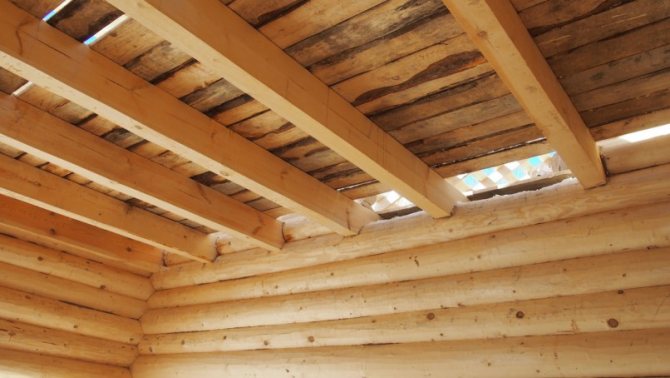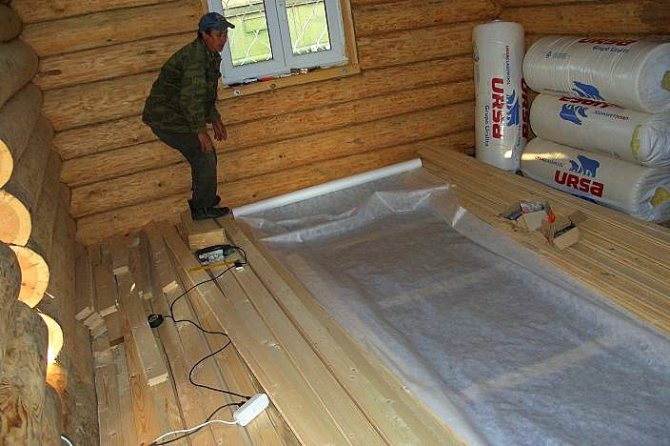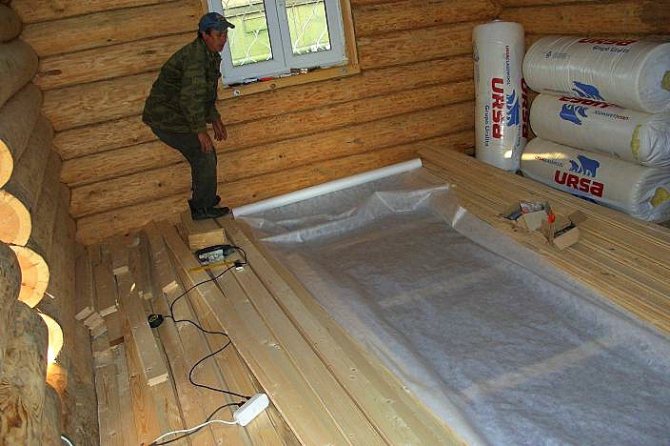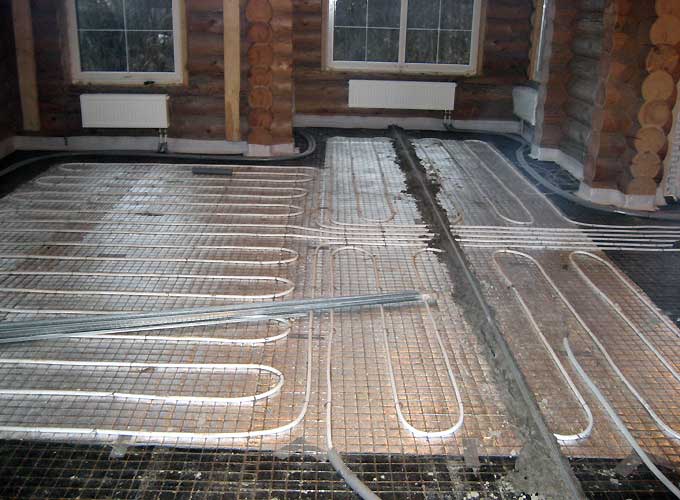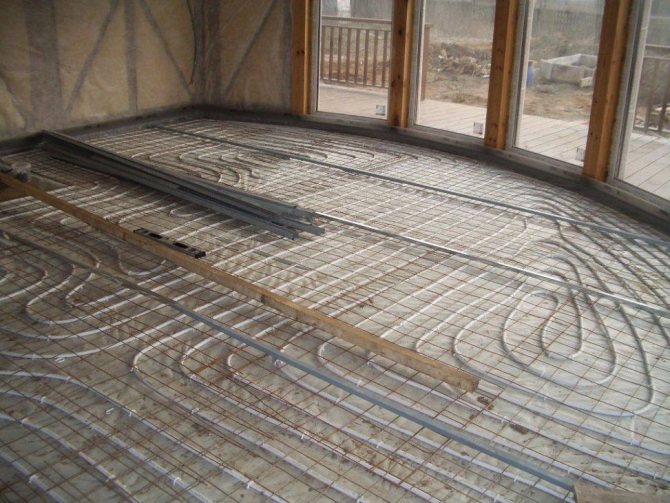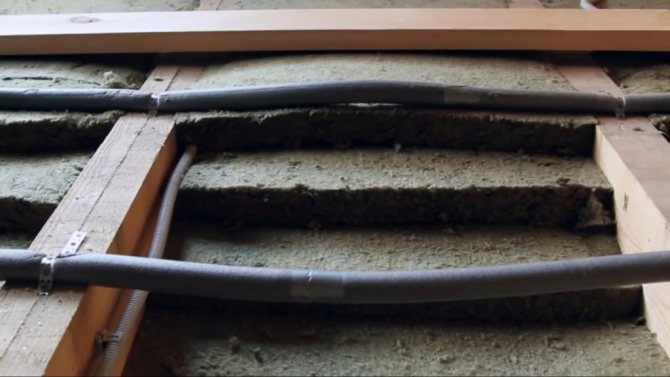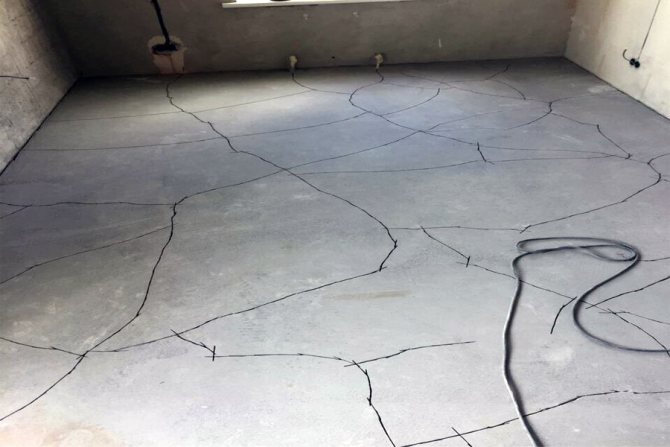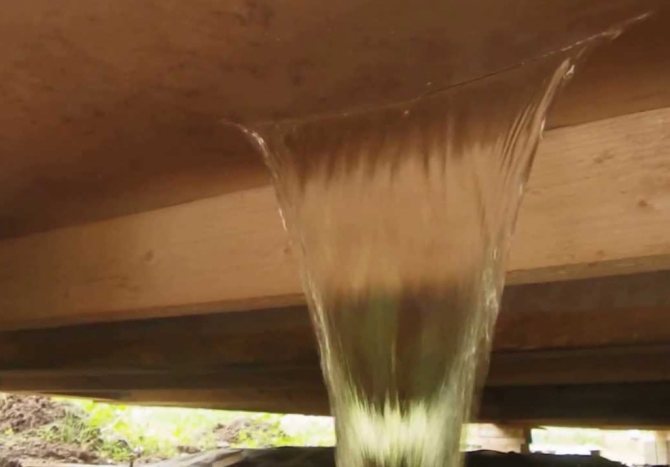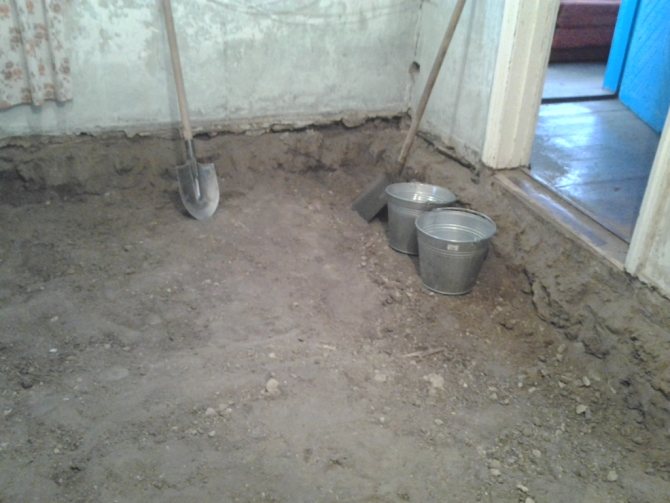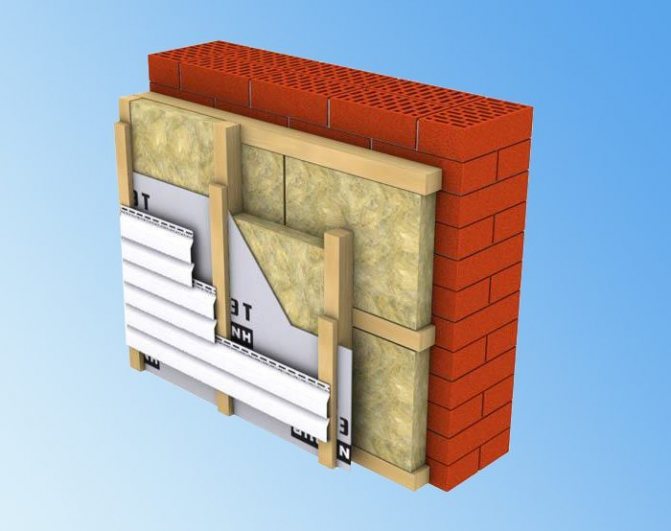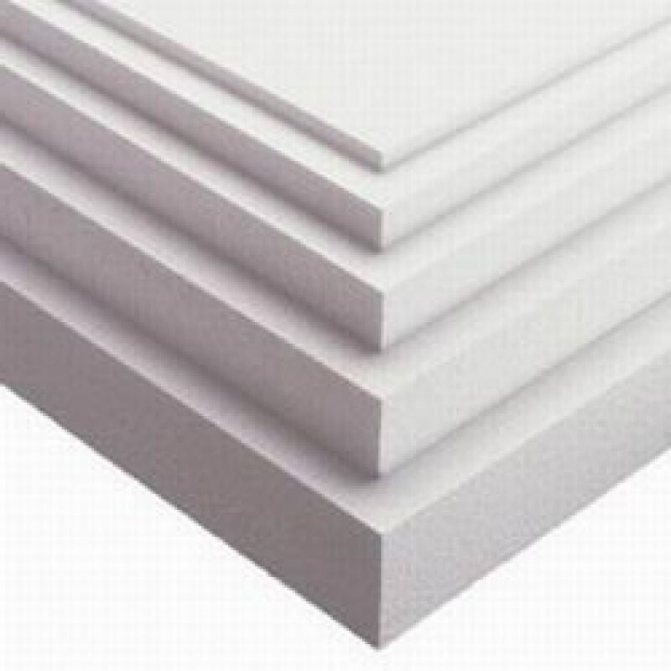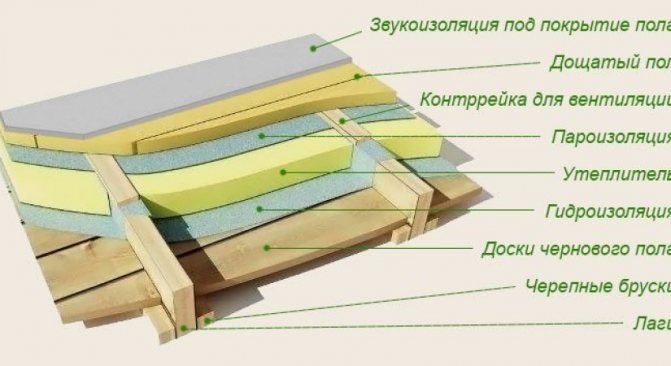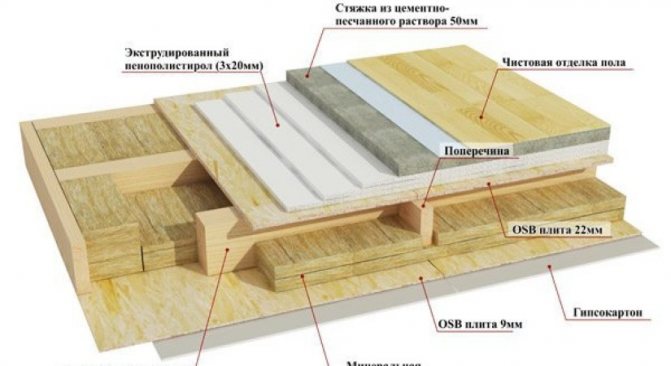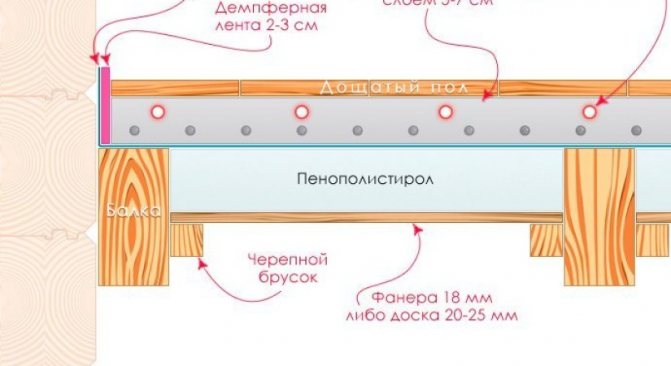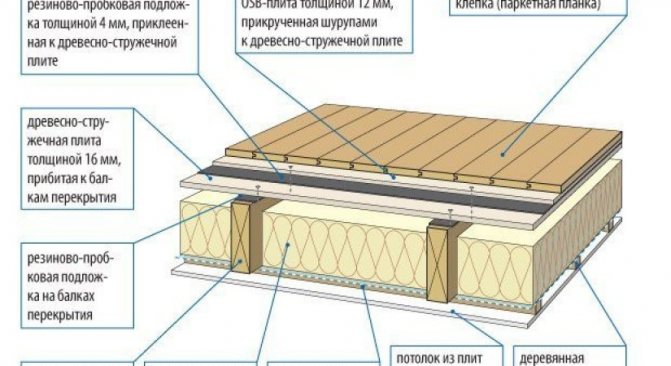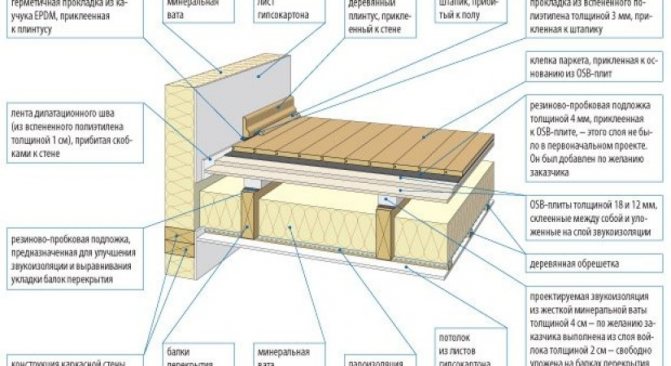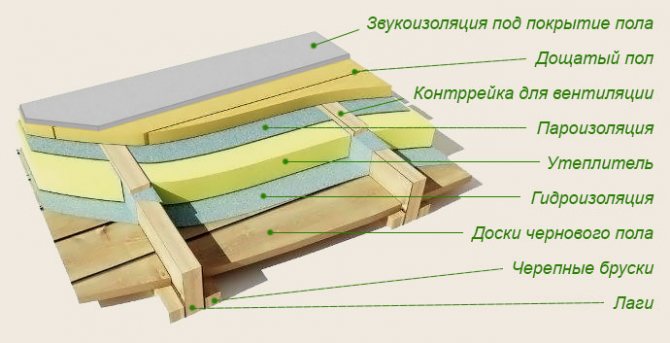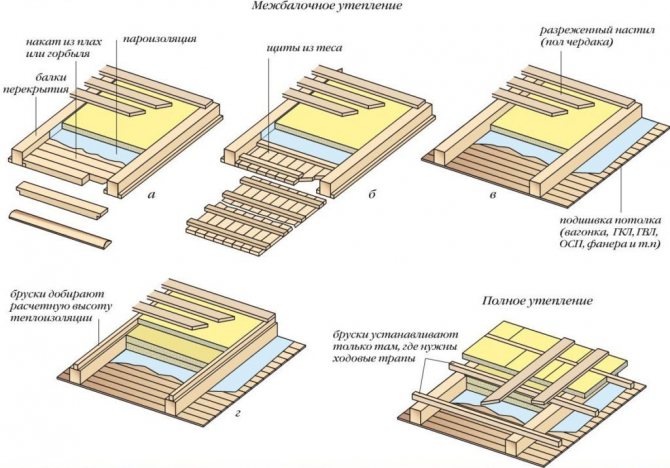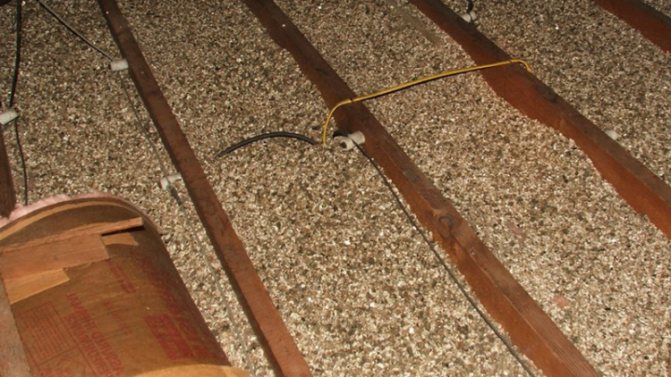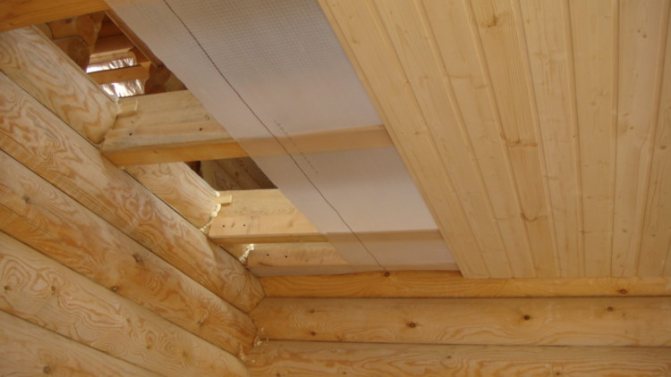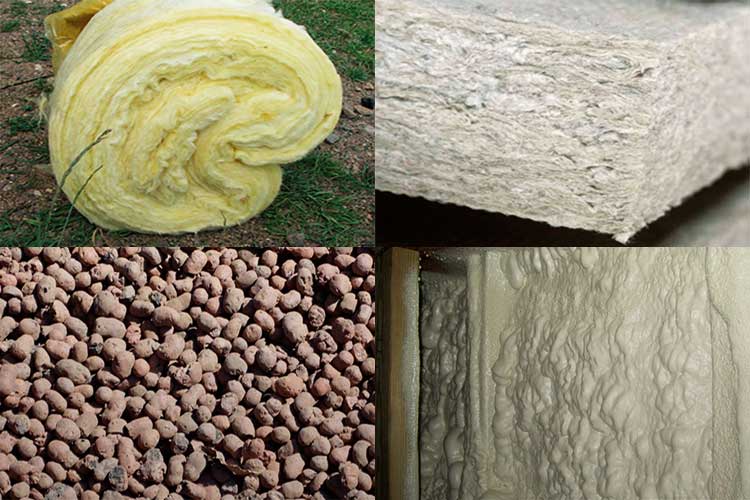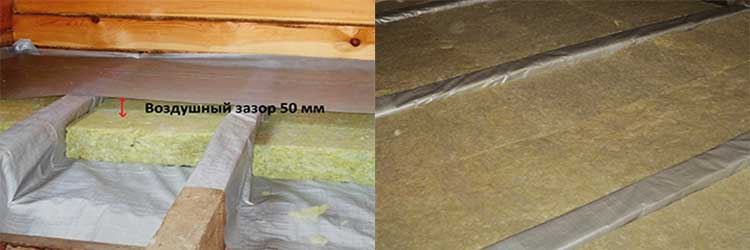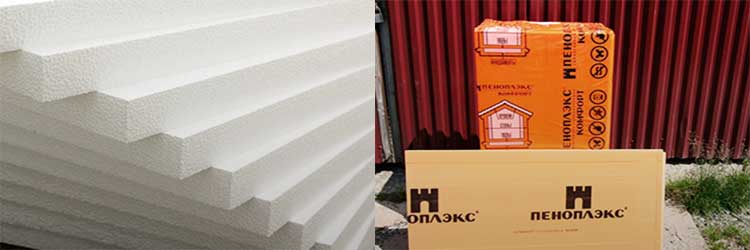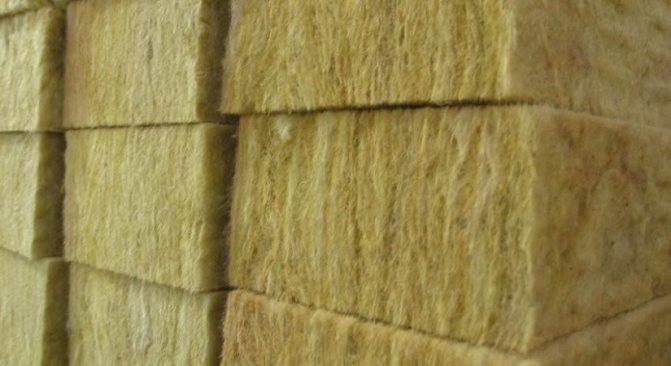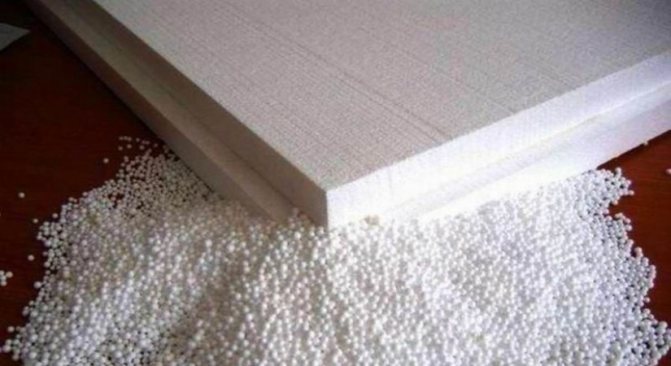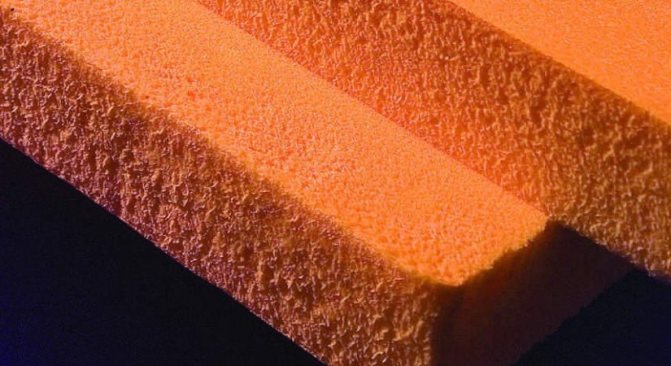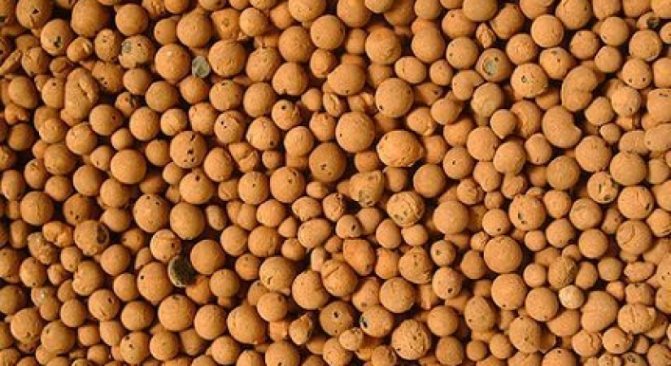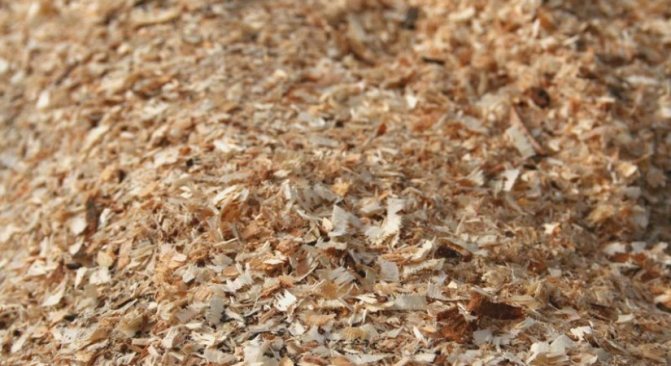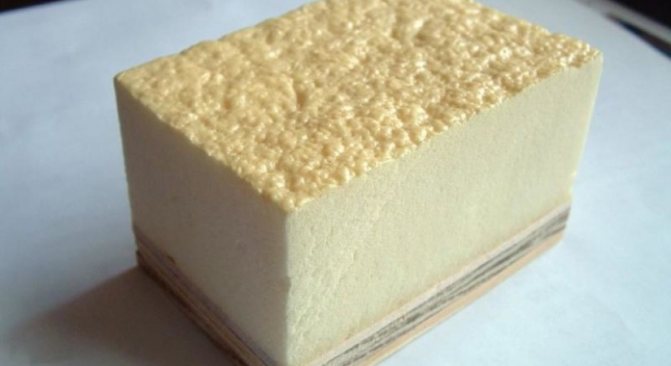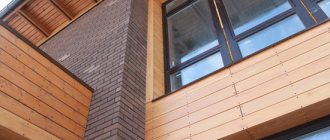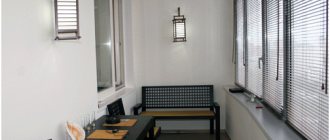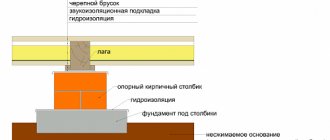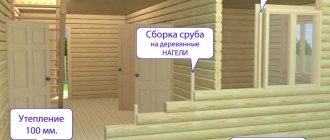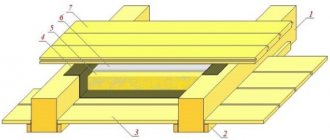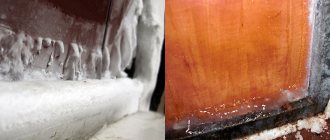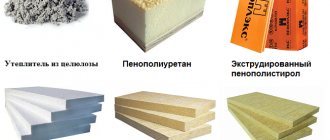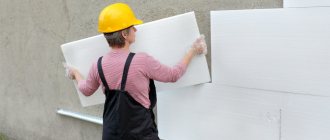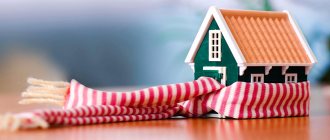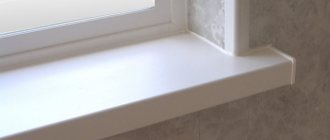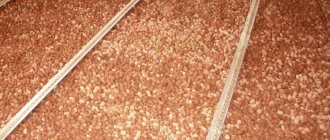None of the villagers who have lived in it for at least one autumn-winter season even argue about the advisability of floor insulation in a wooden house. There can be no two opinions on this issue - it is imperative to insulate. It is only necessary to properly insulate the floors in a log house so that it is effective and money is not wasted.
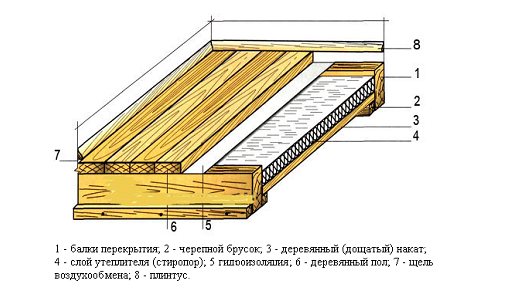
General scheme of wood floor insulation.
Regardless of the region where the wooden house was erected, from its climate and weather conditions, warm or cold winters, dry or rainy autumn, you cannot live in such a dwelling for a long time without an insulated floor. In addition to the fact that it is almost impossible to completely heat it up to comfortable conditions of stay - it pulls cold on the legs from below, and the head is in the heat, so the house itself will collapse from below. The building will draw moisture from the ground and gradually rot, starting with the foundation, plinth, log and floorboard. And rotten boards and logs will not improve the climate in the rooms.
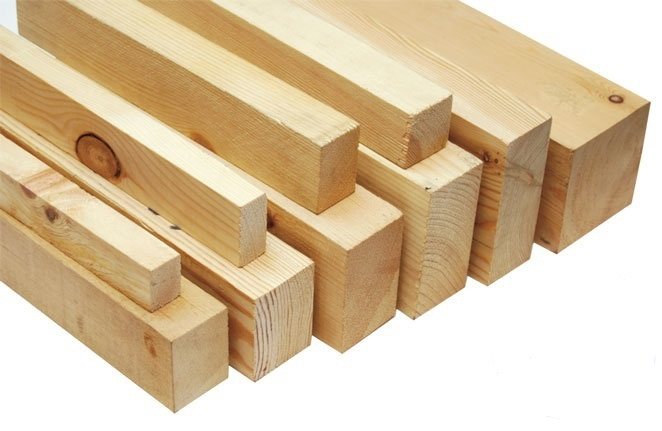

When choosing a material for a log, you should pay attention to the degree of moisture in the wood. The use of freshly cut material is unacceptable, in order to avoid the destruction of the future structure.
At the moment, in suburban construction and in rural areas, the construction of prefabricated frame and log houses is practiced. A frame house is being built quickly, within a maximum of a month it is already ready to live in it. All its elements are divided into modules, which are manufactured in factories, and are assembled locally on the frame.
A house from a bar is built much longer and, in comparison with a frame house, is a capital structure. And the requirements for the comfort of housing are different. Consequently, the approaches to protection from external influences of natural forces and phenomena are also different in terms of complexity and methods of solution.
Benefits of wood
Overlappings are horizontal structural elements of buildings and structures, dividing them into floors or separating them from technical rooms (attic or basement). Depending on what material the building is built from, the floors can be monolithic, prefabricated reinforced concrete or wooden.
For the construction of a private house, floors on wooden beams are most suitable, since their weight is less than that of structures made of other materials, and building them with your own hands is cheaper and easier.
Wooden interfloor floors can be arranged in houses from any material, with the exception of monolithic reinforced concrete. They are erected simultaneously with the construction of the walls, as the latter are erected to the height of the next floor. In timber frame buildings, floors can be performed simultaneously with the construction of the frame of the entire building, even before it is insulated and cladding.
Why insulate a wooden floor
Wood, in comparison with concrete, is a rather warm material, but when building a frame private house or a house from a bar with your own hands, it is not always possible to achieve a rational balance of the thickness of the structure in terms of strength and thermal conductivity. To reduce the consumption of materials on walls and foundations, thermal insulation is necessary. It is possible to carry out insulation work both in the old, long-commissioned building, and in new construction.
Insulating a floor in a wooden house can prevent the following problems:
- the appearance of excessive dampness in the room;
- lowering the temperature in the task;
- condensation, as a result of which mold appears;
- the appearance of a fungus and other microorganisms dangerous to humans;
- increased heating costs;
- destruction of wooden structures from the inside.
By doing the work with your own hands, you can significantly reduce costs. Now there are many materials, the use of which does not require special skills and high qualifications.
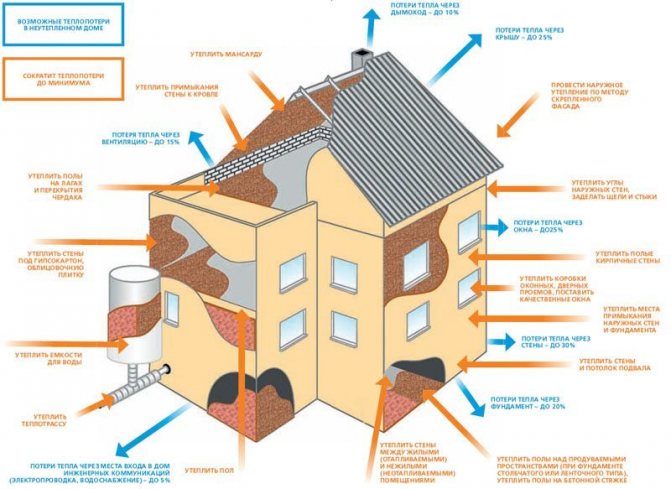

Diagram of all heat losses of a wooden house.
How and what to insulate the ceiling on the second floor
Your own house made of wood is deservedly considered the most environmentally friendly type of home and is the dream of almost every city dweller.
Nowadays, one-story buildings are a rarity, two-story houses are much more common, where guest or children's rooms, bedrooms and recreation areas are located on the second floor.
In the process of interior decoration of a wooden house, the question of insulating the second floor often arises: it is important to choose the right materials and comply with all the rules for using insulation.
Insulation of the floor of a wooden house is a procedure, the implementation of which is closely related to the design features of the room. It is possible not to make a full-fledged second floor, but to build a simplified version of the superstructure - an attic.
The main difference between the second floor and the attic is the proximity of the roof in the second version. This determines the features of work, the main purpose of which is to preserve heat in the attic:
- due to the wide variety of materials on the modern market, the choice of insulation depends on the preferences and financial capabilities of the customer;
- the walls of the second floor should be insulated from the inside and outside;
- the process of warming the second floor of a wooden house does not need to be equipped with a vapor barrier system - in contrast to warming the attic, where it is needed.
In a wooden house above the second floor, there must be an attic space. To prevent the penetration of heat from the first level upwards, the ceiling must be well insulated. The heat insulator layer should consist of several types of insulation materials, which should be laid in a given sequence.
Typically, the insulation "pie" of the floor in a private wooden house consists of the following elements:
- the ceiling of the first floor;
- vapor barrier;
- load-bearing beams made of high-quality timber;
- mineral wool, laid in cells formed by beams;
- waterproofing;
- any floor covering.
This sequence must be strictly observed, otherwise the effectiveness of the thermal and waterproofing of the second floor may suffer significantly. If the second floor will be occupied by a teenager who likes to listen to loud music, or if the house is near the roadway, you should take care of the issue of high-quality sound insulation of the floor and walls of the room.
In addition to the heat-insulating material, two layers of plywood are added to the "pie", which create a sound barrier. When using expanded clay during insulation, a concrete screed should be made from above.
After the overlap of the second floor is insulated, care should be taken to prevent heat loss through the ceiling. The attic is located in close proximity to the roofing.
The role of insulation is played by mineral wool, which is recognized by experts as one of the best materials for insulating an attic. Those who are concerned about environmental friendliness prefer ecowool.
Wool of the selected type is laid in the cells formed by the rafter structure.
Minvata is produced both in rolls and in slabs - its elastic elements quickly and conveniently fit between the rafters. Plates are placed on the ceiling of the upper floor in several ways:
- by pressing mineral wool into the cells of the rafter structure. The thickness of the slabs should be at least 20 cm. This method is the most costly, but it is very popular among builders, since it is distinguished by its simplicity of execution;
- laying insulation boards only under the rafters, which requires additional lathing.The consequence of such insulation will be a decrease in the volume of the attic. Homeowners rarely make such sacrifices;
- installation of mineral wool slabs under the rafters and between them, which requires the installation of additional frame elements. Given the reasonable costs of labor and material, this method has its adherents.
When the ceiling of the second floor is located under the attic, the ceiling should be insulated on both sides. That is, first there should be the floor of the second floor, then the ceiling, then the attic floor.
This approach is due to the lack of heating in the upper level of the building. For this purpose, a vapor barrier is laid on the ceiling of the upper floor, which serves as a barrier for warm air leakage into the attic.
For the purpose of insulation from the inside of the second floor in a wooden house, two technologies can be used:
- internal thermal insulation, carried out by a ventilated method;
- insulation outside, which is done wet or dry.
Internal thermal insulation is justified in the absence of the possibility of performing external work to save heat in the building.
The low popularity of interior decoration at home is due to a number of reasons:
- decrease in the area of the upper floor;
- freezing of the outer side of the walls, which leads to the appearance of condensation and destruction of the material;
- Condensed moisture is the main cause of mold development, which poses a danger to the microclimate in the home.
In the course of wall insulation from the inside, the sequence and the following points should be observed to minimize the above disadvantages:
- preparation of walls, consisting in filling gaps with tow and treating surfaces with antiseptic agents;
- fastening horizontal slats for the purpose of ventilation, which provides air access to the heat-insulating material;
- installation of a vapor barrier membrane;
- installation of vertically arranged racks for further fastening of mineral wool slabs;
- the insulation should be laid between the posts made of an aluminum profile or timber;
- installation of a vapor barrier;
- finishing with plasterboard, chipboard, clapboard, etc.
External wall insulation assumes the same sequence of work, only without installing a ventilation crate. These methods of thermal insulation are carried out “on dry”, but in practice, “wet facade” insulation is more often used.
The facade of a wooden house is insulated using the wet method:
- the walls are prepared and treated with an antiseptic;
- mineral plates are glued to a special composition and additionally fixed by means of umbrella dowels;
- a reinforced mesh is glued to the insulation, the mixture is leveled with a wide spatula;
- a thin layer of glue is applied and finally leveled on the walls;
- the walls are plastered and the facade is painted (if necessary).
Sequence of work:
- bars are installed along the walls of the pediment;
- a distance equal to the thickness of the sheet of heat-insulating material / - 0.5-1 cm must be maintained between the bars;
- the vapor barrier material is laid;
- mineral wool slabs are installed;
- a layer of vapor barrier is laid;
- sheathing is made with finishing material.
For more details about the attic insulation, we write here
Through glass surfaces, windows and doorways, there is an active leakage of heat from the room. Despite the presence of double-glazed windows, the slopes must be additionally insulated. For their insulation, it is recommended to use expanded polystyrene, foam or other cellular material. The insulation of the loggia is carried out in the same way as the insulation of the pediment.
Conclusion
Correctly executed thermal insulation of the walls, floor and ceiling of the attic will provide a comfortable atmosphere in the cold season.
Today, one-story houses are rarely built from wood.Basically, preference is given to two-storey spacious buildings, in which there is a lot of living space, and a large family can freely accommodate. At the finishing stage, the owners often face the question of how to insulate the second floor of a wooden house.
And it is by no means idle, since the process of thermal insulation of the 2nd floor depends on many factors. In particular, this is influenced by the design features of a log house, for example, a heated attic or an unheated attic may be located above the upper floor. Thermal insulation in these two cases will be carried out in different ways. And there can be many such nuances.
Therefore, in the article we will analyze the main issues that arise when insulating this part of the house, and describe in detail the process itself.
We offer you to familiarize yourself with Heating on the second floor of a private house
This indicator plays a decisive role in determining the plan for thermal insulation of the second floor in a private house. Structurally, the room can be:
- A full second floor, above which there is an unheated attic or living room.
- Attic, which is located directly under the roof.
In each case, the principle of insulation will be different. The main difference between an attic and a full-fledged floor is the proximity of the roof, so the main task of insulation is to keep the room warm.
It should be emphasized that the thermal insulation of the second floor must be made not only inside, but also outside the house. When insulating a full-fledged floor, you do not need to equip a vapor barrier layer; vapor barrier is mandatory for the attic. Expanded polystyrene, mineral wool or expanded clay are most often used as insulation.
The work consists of three stages:
- Thermal insulation of the interfloor overlap.
- Heat protection of walls.
- Insulation of the attic of the house.
It is more convenient to carry out the work from the side of the upper floor, the material will be laid on the boards, which are the ceiling of the first floor.
- In order for the insulation to be of high quality and effective, it is necessary to dismantle the floor of the second floor.
- The next stage is the laying of a vapor barrier layer. Above we wrote that the vapor barrier of the second floor can be omitted, but to prevent the accumulation of condensate in the insulation, and to extend its service, it is best to lay a vapor barrier film on the shields and beams.
- Further, the space between the beams is filled with thermal insulation, the material is laid very tightly so that there are no gaps and gaps between the slabs and the ceiling. If expanded clay is used, then all cavities are filled with granules, and then they are well leveled.
- Then the insulation is covered with a waterproof film on which a wooden floor is laid.
If thermal insulation cannot be made from the side of the second floor, then work is carried out from below in the following sequence:
- The ceiling of the first floor is being dismantled.
- Waterproofing is attached to the floors with a stapler.
- Insulation mats are laid between the beams and fixed with wooden slats.
- The structure is closed with a vapor barrier film, which is fixed with a stapler.
- A ceiling covering is mounted, it can be drywall, chipboard, plywood sheets, etc.
Heat protection of walls
Usually, the walls are insulated from the outside. Internal insulation is done in cases where, for some reason, the work cannot be done outside.
We lay a tongue-and-groove board
The insulated frame floor system has solid wood elements that serve as excellent cold bridges. To prevent heat outflow, you can cover the frame system of the floor with a heat-insulating and moisture-resistant material, such as GVLV or MGL, and then lay the boards, having previously outlined the position of the log.
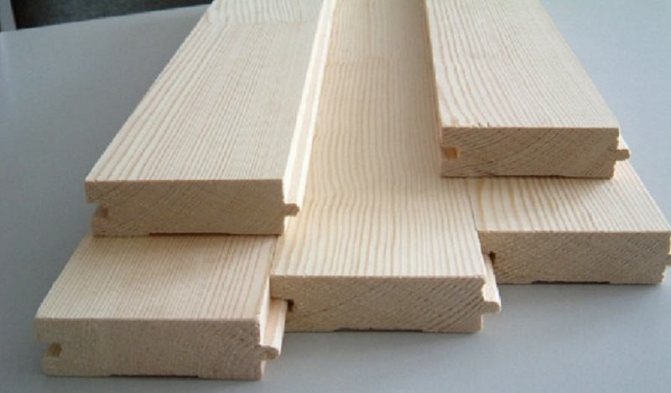

For an insulated floor, it is recommended to use a tongue-and-groove board with expansion grooves on the seamy side. Such a flooring will not creak when walking, it is less susceptible to uneven shrinkage and warping.Due to the tight joining of the boards, any kind of blowing between them is excluded. If a limited air circulation is planned under the floor, then the holes for its inflow will be spaced gaps of 10-15 mm at the walls, which also serve to compensate for the linear expansion of the wood.
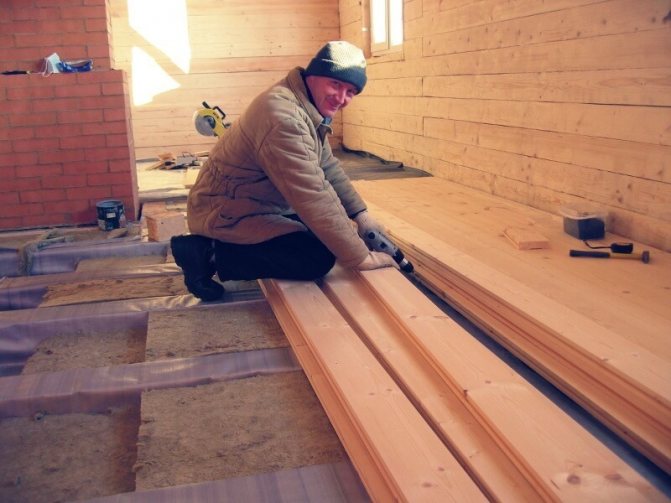

When flooring, a ridge is cut from the end of the first board, the groove is oriented towards itself. Fastening is carried out in each lag, one or two points. The boards are fixed with ragged nails, which are hammered obliquely into the groove and finished off, guiding the steel bar. For high-quality rallying of boards 20-30 cm in front of them, a beam is temporarily attached to the logs and the loose floorboards are squeezed from it with a lever or a car jack.
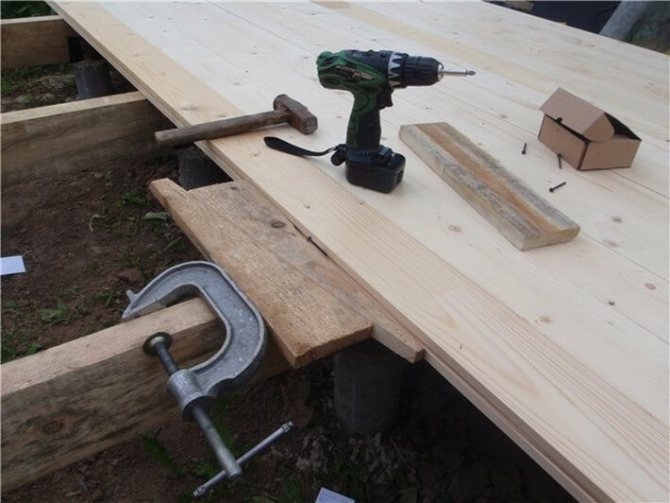

The last board in the set is cut to fit the remaining gap, taking into account the curvature of the walls. It is squeezed from the wall by mounting through a lining of a wooden bar, and then attached to the logs right through from the surface. Traces from fastening with nails are subsequently covered with a plinth. published by econet.ru
Did you like the article? Write your opinion in the comments. Subscribe to our FB:
Correct sound insulation of wooden floors
The overlap, made along the beams, is represented by wooden beams, which are laid at a certain distance from each other. They determine the degree of strength and reliability of the entire structure. Usually they are sheathed (on one side or both) with various materials of a flat configuration. These can be sheets, panels or slats. Inside the structure equipped with this method, voids arise between the beams, inside which it is convenient to lay insulation.
The technologies described above are designed to serve as efficient insulation of floors as possible. It is important to remember that in addition to thermal insulation, there are other important standards related to the criterion of sound insulation. Some of the insulation insulates noise well and does not require additional measures in this direction.
- Laying mineral wool with a density of 50 kg / m3 and above in a layer of 100 or more millimeters.
- Installation of special acoustic mats with a density of 30kg / m3 and a thickness of 100 millimeters.
- Building felt stuffing. Its density is from 20 to 30 kg / m3, the required layer thickness is from 20 to 40 millimeters.
Interfloor floors made of wood are arranged along the beams. They are usually used as a bar. The size of the section depends on the size of the span to be covered, as well as on the expected load on the floor and the types of wood used. Most often, a beam with a section width of 100 mm and a section height of 150-200 mm is used.
Further, the overlap itself is formed by installing the floor boards of the upper floor and hemming the materials of the lower floor ceiling. You can often see that the floor boards are laid directly on the beams, but it is more correct to first mount the logs on the beams, and then make the flooring from the boards along them. The second option is the most preferable, as it will make it possible to produce the correct interfloor insulation on wooden beams.
The fact is that in the cake, to which the filling of the interfloor overlap is so similar, layers of vapor barrier must be present.
They are made of a special membrane with a certain coefficient of vapor permeability, and the upper layer of the membrane allows steam to pass only in one direction - from the insulation into the air. Therefore, an air gap is required between the membrane and the floor board, which will remove steam from under the boards. Otherwise, the latter will simply start to rot.
In this case, the membrane is laid on the floor beams, and the air gap is formed due to the thickness of the lags, laid perpendicular to the beams.
Steam is removed from under the boards through holes specially cut in the floor or slotted skirting boards used for edging the perimeter of the room.
This is necessary so that moisture from the lower rooms does not seep up through the interfloor ceilings, and also does not linger in the layers of insulation. All air from the floor must be vented to the atmosphere only through ventilation ducts or windows for ventilation.
Installation process
Having decided on the material for thermal insulation, the question arises: how to properly insulate the attic floor? If we talk about mineral wool, what density should it have and what layer of insulation will be the best?
The choice of layer and density of mineral wool
Mineral wool insulation is best done in two layers
In short, the larger the layer of mineral wool, the better. However, it must be remembered that mineral wool has its own coefficient of specific thermal conductivity. The smaller this coefficient, the higher the thermal insulation properties, and, therefore, you can lay a smaller layer of cotton wool or have a higher insulation efficiency. Often, mineral wool with a thickness of 15-20 centimeters is used, however, to provide increased thermal insulation, a 30-centimeter layer of insulation can also be used. It is also worth noting that with an equal thickness of insulation, two layers of mineral wool are always better than one.
You also need to pay attention to the density of mineral wool, because it can be different: from 30 kg / m3 to 220 kg / m3. Thermal insulation properties practically do not depend on density. A denser insulation is used for facades and screed floors. Mineral wool with a density of 35 kg / m3 is also suitable for the attic floor, because the insulation will be on a horizontal unloaded surface.
Vapor barrier
Since mineral wool has the ability to absorb moisture, you need to start insulation with the installation of a vapor barrier material.
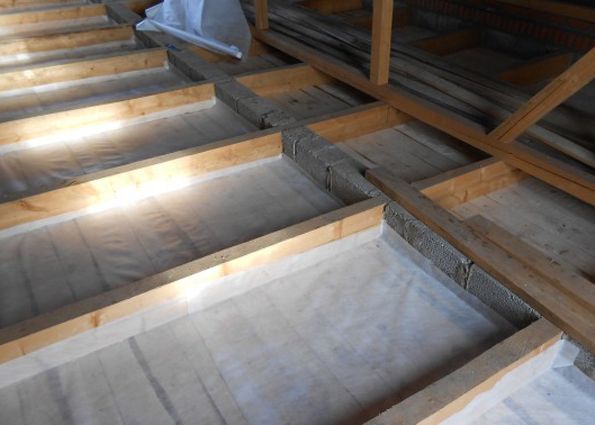

Vapor barrier - the first layer of insulation
Important! It is best to lay a layer of vapor barrier under wooden beams, otherwise they will be very susceptible to decay. Nevertheless, if it is impossible to put a vapor barrier film under the beams, they must be impregnated with solutions that protect against decay and mold.
The best option is to lay a continuous layer of vapor barrier, but due to the size of the attic this is not always possible, so all joints must be glued with special tape to ensure tightness. The edges of the vapor barrier must be raised above the level of the future insulation and glued with the same tape.
Thermal insulation
You need to work with heat-insulating materials in overalls
This is followed by the installation of insulation. It must be laid in such a way as to completely fill all the space between the timber beams. When it comes to mineral wool, then it does not need to be pressed or squeezed. It must completely cover the space between the beams, leaving no gaps or gaps. The floor beams themselves will also not be superfluous to cover with heat-insulating material, because they can serve as a kind of cold bridges.
When laying mineral wool, it is very important to protect yourself, and especially your respiratory tract, from the ingress of insulation fibers. Therefore, you need to use a respirator, as well as gloves, goggles and long-sleeved clothing.
Insulation layers
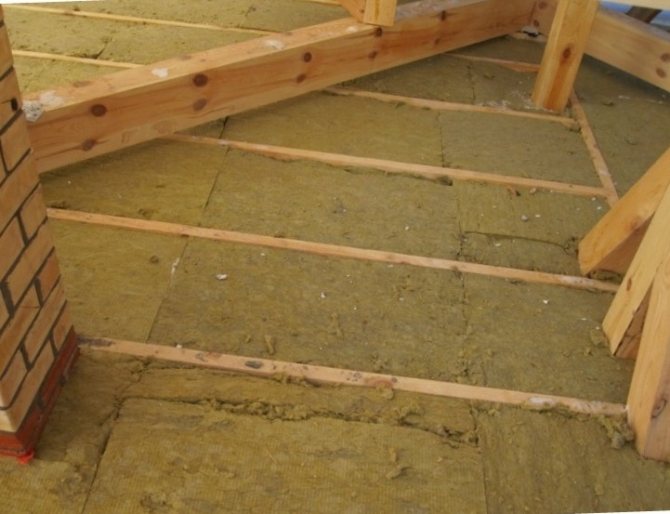

So, if you imagine a cross-sectional insulation cake, it will consist of the following layers:
- floor boards of the upper floor;
- lags;
- vapor barrier of the floor;
- beams with a layer of heat and sound insulation between them;
- vapor barrier of the ceiling;
- ceiling lining.
In multi-storey buildings, the insulation of the interfloor overlap is relevant only if this overlap is made between the basement and the first floor, as well as in the case of overlap between the upper floor and the unheated attic.
If the overlap separates two residential heated floors, then the role of the insulating material for insulation is negligible.In this case, the sound insulation properties of the structure are much more important. Despite the fact that heat and sound insulation materials are included in the same group when classified by purpose and technological characteristic, their properties may be different.
These differences must be taken into account when using this or that material in a particular interfloor overlap.
How it works
Beams
A plank floor in a log house begins from the base - beams, which at the same time perform the function of a log. In this capacity, a bar with a section of 100x150 millimeters is used. The wider edge of the bar is located along the load vector - vertically. The step between the beams is no more than a meter: otherwise, you will still have to lay the logs across the beams.
How are timber floor beams attached? Their edges cut into the walls - usually between the first and second crowns. The beam is upset in the slot and fixed in it with dowels. Better - wooden.
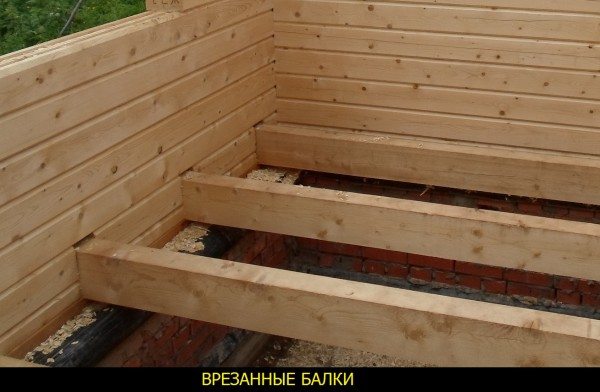

The grooves for the beams are through, for the entire thickness of the walls.
Let us make a small lyrical digression. Why are not nails, not practically eternal galvanizing, but a seemingly less durable tree preferable for a bundle of timber?
The builders dismantling old houses noticed a curious thing: steel in the thickness of the tree becomes a hotbed of decay. Moisture condenses on the surface of steel elements, which, in fact, leads to unpleasant consequences. Obviously, a steel dowel surrounded by dust will perform the function of fixing a structural element more than badly.
As a rule, birch without knots and with fibers parallel to the axis of the product is used for the manufacture of dowels. Antiseptic impregnation is, of course, highly desirable.
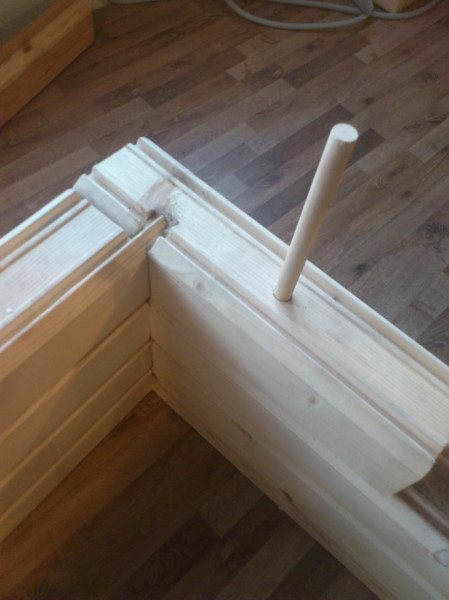

Our choice is wooden pins.
Rough floor
To the bottom of the side surfaces of the beams, the so-called cranial bar for the floor is sutured, having a cross section of at least 30x30 mm. It will become a support for the subfloor boards. Here you can already safely use nails or, what is better, galvanized self-tapping screws.
Cut-to-size boards with a thickness of 20-25 millimeters are laid on top. The load on them will be minimal, so much strength is not needed.
A vapor barrier is laid on the rough floor. In this capacity, inexpensive glassine is often used - a product of impregnation of thin cardboard with bitumen. Where the width of one strip is not enough, glassine is laid out with overlapping canvases.
Insulation
There are no special requirements for it.
Let's list those methods of insulation that can be done by hand without involving any complicated and expensive equipment.
- Glass wool is probably the cheapest thermal insulation material. Its main drawback - the volatility of fibers that irritate the respiratory system - in this case is neutralized by waterproofing and a clean floor.
- Mineral (in particular, basalt) wool is not much more expensive. It is believed that it is somewhat less hygroscopic and less caking.
- Ecowool is a cellulose processing product containing a fire retardant and antiseptic. Unlike previous materials, it does not lose its thermal insulation properties when wet up to 30% moisture.
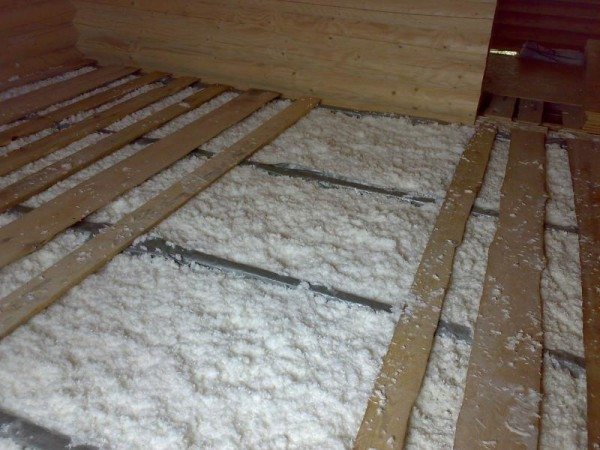

Thermal insulation of the floor with ecowool.
- Polyfoam is noticeably more expensive than other insulation options; however, it has an extremely long service life, the best thermal insulation properties and constant linear dimensions.
A couple of nuances are associated with the warming process:
- Loose and mineral wool insulation cannot be compacted. At the same time, they begin to conduct heat better. However, gaps should be avoided.
- It is better to foam the gaps between the foam plates in order to avoid the occurrence of convection currents that carry away heat.
As already mentioned, it will not hurt to lay a layer of waterproofing on top of the insulation. An overlapped, glued-on plastic wrap will work fine.
Finishing floor
A practical, extremely durable and environmentally friendly solution for a wooden house is a tongue-and-groove flooring. The thickness depends on the step of the lag: at 80 cm, a 28 mm board is enough, at a meter - 36 mm.
Of course, it is advisable to take a dried board: by buying raw lumber, you doom yourself to the need to re-peg the floor in six months or a year. In addition, the board can become loose during the drying process.
What can be done to the surface of a plank floor?
- After scraping, the boards can be covered with parquet varnish. The best choice is a water-based polyurethane varnish, which gives an extremely durable finish and is free from harsh odors.
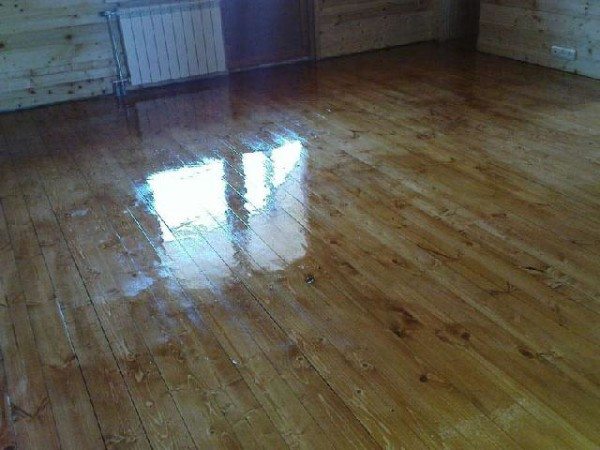

The photo shows a varnished wooden floor.
Please note: of course, the varnish is only applied to a completely dried floor. Varnishing a damp board will make it less even drying and increase the likelihood of warping and cracking.
- Nobody canceled the painting of the floor either. Alkyd PF-266 and its imported counterparts perfectly fit on a dry board. The enamel is extremely wear-resistant; the only problem with Russian retail is that it is difficult to find a floor paint color that does not belong to one of the many shades of brown.
- Linoleum is a practical and inexpensive finishing option. Preferred is not household linoleum, but semi-commercial: it is much more durable.
- Laminate is the ideal floor covering if you want to warm your floor. About its structure - in the next section of the article.
Thermal insulation materials suitable for floor insulation
Mineral wool
Differs in high thermal insulation performance, and is also a wonderful insulator against extraneous noise that can penetrate into the home from the outside. It is produced in the form of rolls or mats. Among the disadvantages of such insulation, one can note the high ability to absorb moisture. Because of this, this material requires the arrangement of an additional waterproofing layer. Among the advantages, in addition to the basic properties, one can name an affordable level of cost.
Their heat-insulating qualities are comparable to those of mineral wool slabs, but the ability to muffle sound is much lower.
Polyurethane foam
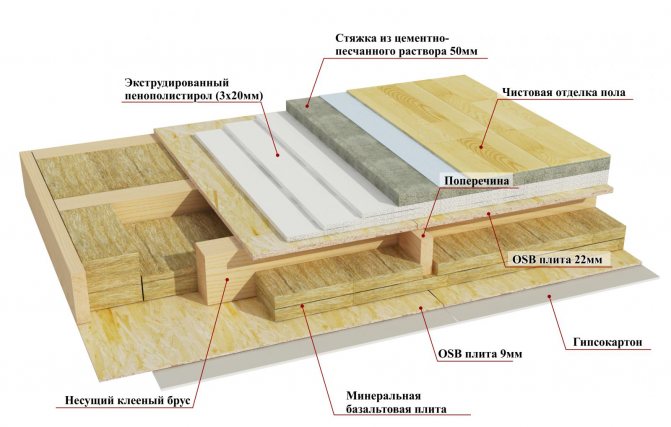

This insulation belongs to the highest quality materials. It is a foamy structure, which is applied by spraying to the insulated surface. When cured in air, the foam forms a durable, dense coating. It has no noticeable flaws, but it has a high price tag.
Expanded clay
Loose material, consisting of porous granules of various diameters, which was originally intended for insulation of floor slabs.
Sand as a soundproofing layer
Sand sound insulation has been used for a long time, because the material has the ability to absorb both low and high sounds. In its mass, it is porous with fine cells inside between the particles. It is there, reflected from the walls of the air chamber, that the sound waves are damped.
But sand has several negative characteristics:
- high specific gravity, which requires the construction of floors using powerful beams and a rough base (ceiling);
- high thermal conductivity, insulation of floors with sand is impossible, you will have to add an additional layer of heat-insulating material;
- if you do not assemble a sealed structure, filling up all the cracks and holes, then the sand will penetrate into the premises of the house.
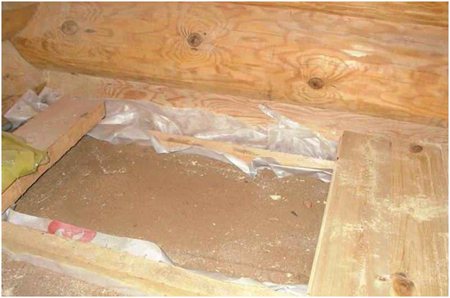

Sand is used as a sound insulation layer in wooden floors
Heaters
Various heat-insulating materials can be used as interfloor insulation of a wooden house:
- glass wool;
- basalt wool;
- slag;
- Styrofoam;
- penoplex;
- expanded clay;
- foamed polyurethane;
- shavings, sawdust.
The choice is based on the availability of the material, its cost, characteristics. So, mineral wool and expanded clay are the most acceptable from the point of view of fire safety.At the same time, penoplex does not absorb moisture, does not cake, and has high thermal insulation properties. Sometimes materials are combined, increasing thermal protection.
Different types of cotton wool
Most often, various types of building heat-insulating mineral wool are used to insulate interfloor ceilings. They are made by melting and pulling the fibers of the feedstock. Further, these fibers are intertwined on special machines and formed into mats or rolls. In some cases, such mats or rolls are stitched with synthetic threads to increase the strength of the products.
For glass wool, waste and broken glass production are used as raw materials, for mineral wool and basalt wool, melts of igneous rocks are used. Slag wool is obtained by melting blast furnace slag.
We invite you to familiarize yourself with Thermal insulation of the floor of the first floor - All about floor coverings
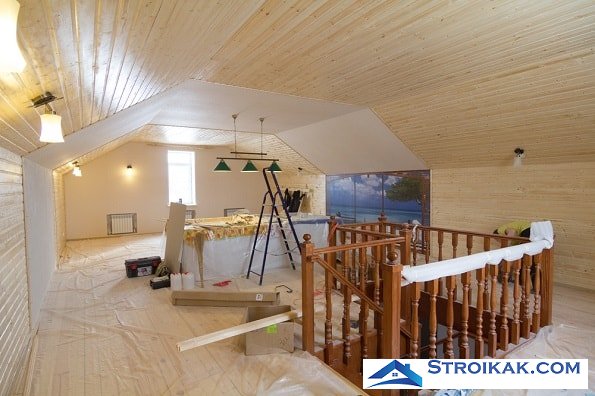

Different types of cotton wool have different properties. They have different densities, different thermal conductivity. These characteristics depend not only on the type of feedstock, but also on the specified production parameters.
These are two materials similar in properties and method of production. The raw materials for their manufacture are plastics of various compositions. During the production process, they foamed and, when solidified, formed into sheets of the correct geometric shape. The difference lies in the fact that the penoplex is squeezed out during formation through a special device - an extruder.
Both polystyrene and penoplex have closed pores filled with gas in their volume. Only in foam is it ordinary air, and when foaming foam, carbon dioxide is usually used. In terms of the coefficient of thermal conductivity, both materials are almost identical. But due to the fact that in the mass of foam pores are more evenly distributed and they themselves have almost the same size, its strength is much higher.
Very often, when forming sheets of foam, their ends are not made even, but in the form of two or more ledges. When insulating, two adjacent sheets, connecting with each other during installation, provide better insulation, since the joints are not blown out and keep heat well.
Expanded clay
Expanded clay is called a building material, which is a set of oval granules - pellets with an average diameter of 10 to 20 mm. The material of these granules is clay and shale sand. The pellets themselves are obtained by firing pre-prepared semi-finished products in special furnaces. When heated in the volume of expanded clay, pores of different sizes appear, as a result of which it has a very low density.
Polyurethane
Foamed polyurethane is used, as a rule, to insulate basement and attic floors. It is simply applied using special equipment, and later it is foamed in air and takes on a volumetric shape. The advantage of using such a material is that it fills all the leaks and cracks in the structure of the floors, allowing you to make a sealed waterproof and windproof heat protection.
Sawdust
Shavings and sawdust have recently been used much less often, but more recently they have also been used to insulate interfloor floors, filling the name of the cavity between the beams. To prevent such insulation from rotting inside the floors, it is treated with special compounds that kill putrefactive bacteria and woodworms. When laying, shavings or sawdust are mixed with lime.
Vapor barrier
To properly insulate interfloor floors, it is not enough to use only materials with thermal insulation properties. If you do not protect the insulation from the action of moisture in the internal volume of the premises, various microorganisms will multiply in the material, which can subsequently lead to mold or mildew.To avoid this phenomenon, it is necessary to make the correct insulation vapor barrier.
Any of the many commercially available options can be used as a vapor barrier. Ready-made protective membranes are widely represented in the building materials market. When building and insulating a private house with your own hands, you can use improvised materials if you know their strength and vapor barrier properties and use them correctly.
As the main layer, the coefficient of vapor permeability of which should be minimal, you can use ordinary polyethylene film or foil. This layer is laid below the insulation, preventing moisture vapor from entering it from the basement or from the lower floor.
As a second layer, which will be on top of the insulation, you can use waxed paper or glassine. These materials are more vapor permeable than foil or polyethylene. They will facilitate the free escape of vapors from the thickness of the insulation upwards.
Materials, their characteristics
In order to decide what is the best way to insulate the floor in a wooden house, it is necessary to carefully study the properties of existing materials. There are different types of heaters on sale that have their own physical and operational qualities. Any of them can be placed under the boardwalk or installed on top of it without removing the old covering. Let's consider the most popular options:
Expanded clay
Loose material in the form of rounded granules. Made from fired clay. It has a porous structure, but the surface of each pellet is covered with a sealed melt film. The main advantage of expanded clay is its durability. The backfill layer can be used several times on different objects, and the material will not lose its qualities. In addition, the advantages of insulation are:
- light weight. Due to the porous structure, the mass of the granules is small. This eliminates unnecessary stress on the supporting structures even when creating a thick layer of insulation;
- low thermal conductivity;
- resistance to temperature changes;
- expanded clay does not burn;
- strength, resistance to mechanical stress;
- installation is not difficult and easily done by hand.
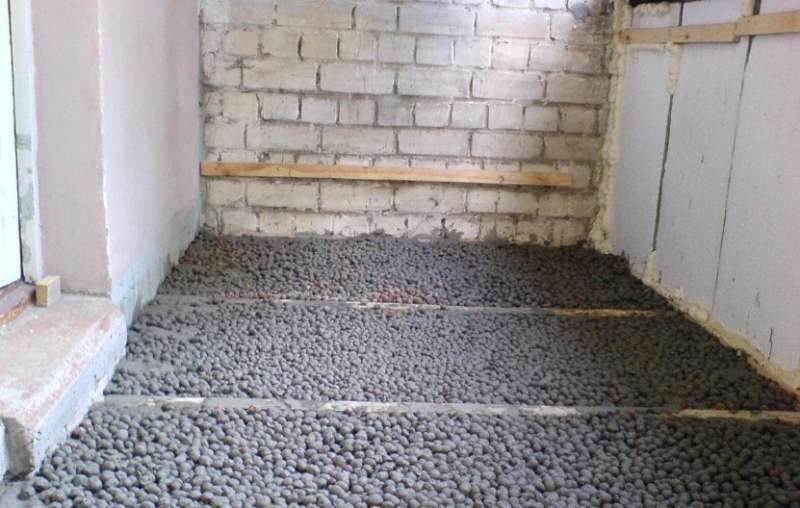

For installation, it is only necessary to fill in a mass of material and level the surface, giving the layer the same thickness. However, to obtain the desired effect, a rather large thickness of the backfill is required - experts recommend laying a layer of insulation of at least 25-30 cm. In addition, it is necessary to monitor the condition of the granules. By themselves, they are sealed and not afraid of moisture, but water that has penetrated into the thickness does not dry out for a long time.
Mineral wool
Popular and demanded insulation used everywhere. Minvata is a collective name for a group of materials, which are:
- stone (basalt) wool;
- glass wool;
- slag, etc.
Basalt wool is most often used, which has the most successful set of qualities. Advantages of mineral wool:
- high heat-insulating qualities;
- light weight;
- resistance to fire or high temperatures;
- there are roll and plate forms of the material, expanding the choice;
- durability.
However, there are also disadvantages:
- the ability to absorb moisture, after which the insulation significantly changes its qualities;
- for installation, supporting structures are required, which complicates the process of insulation.
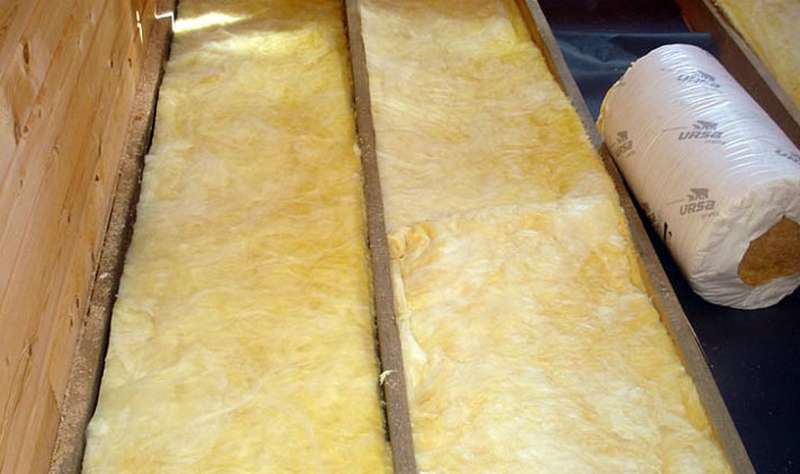

During installation, the mineral wool has to be cut off on both sides from possible contact with steam or liquid water. For this, a waterproofing film is used. The waterproofing layer creates an additional operation during installation, but it cannot be excluded from the technological process. Soaked mineral wool ceases to be a heat insulator and begins to destroy all structures with which it is in contact.
Penoplex
The technical name of this insulation is extruded polystyrene foam. It is a solidified mass similar in texture to polyurethane foam. Possesses high performance characteristics. Penoplex advantages:
- complete impermeability to moisture in any form;
- low thermal conductivity, the ability to create a thermal cutoff even with a small layer thickness;
- light weight;
- does not support combustion;
- durability.
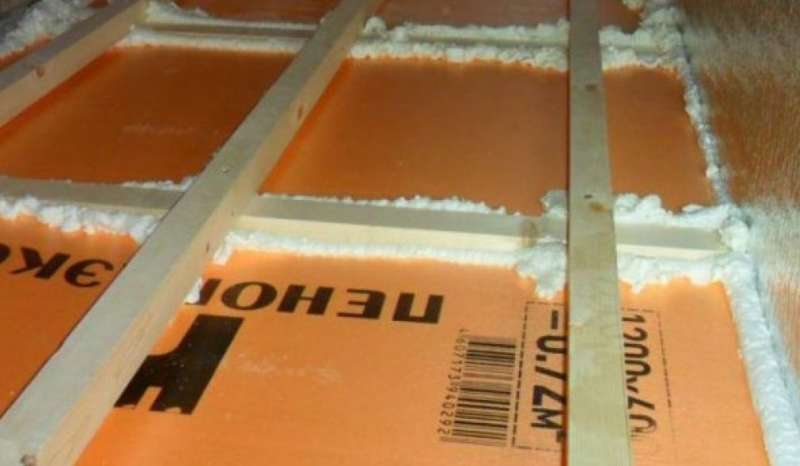

A distinctive feature of penoplex is rigidity. Installation can be carried out both with additional support elements, and with a continuous canvas. The only drawback is considered to be a relatively high price, although today the cost of penoplex is noticeably lower than a few years ago.
Sawdust
Sawmill waste can be purchased literally for a penny. Often they are given away for nothing, just to take out the surplus. Cheapness attracts some owners of wooden houses who are trying to insulate the floor in this way. However, this option has noticeable disadvantages:
- instability to moisture;
- the ability to rot, rot, the possibility of mold or mildew;
- insects or rodents can start in the sawdust;
- the material cakes and loses its quality.
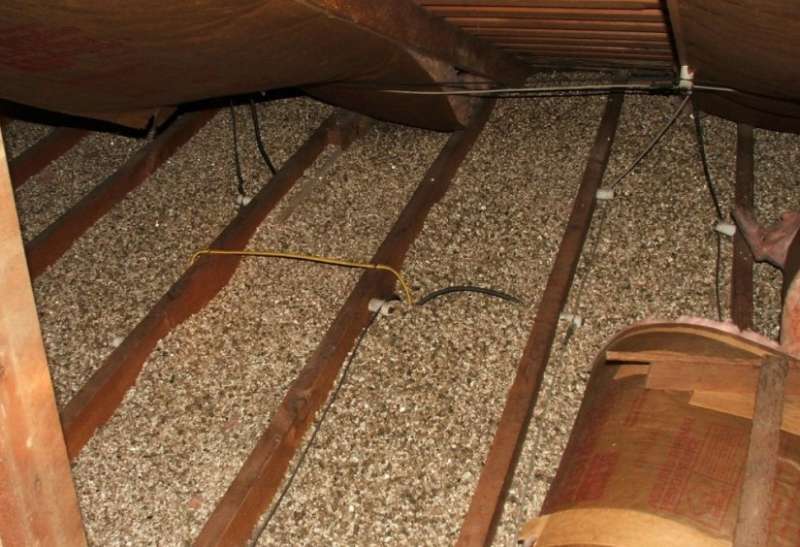

To compensate for these shortcomings, sawdust is mixed with lime, clay or cement mortar. Installation is simple - a thick layer is poured onto a wooden floor and the surface is leveled. Sometimes slabs are made consisting of cement mortar and a large amount of sawdust. Briquettes are stacked tightly, without cracks and gaps, forming a continuous web. The overall effect of the use of sawdust is low, so in today's practice this option is quite rare.
Styrofoam
This is another type of expanded polystyrene. Unlike penoplex, this insulator consists of individual granules. They are sintered in special autoclaves under the influence of superheated steam. Styrofoam properties:
- light weight. In this respect, the material is the leader among all the alternatives;
- high thermal insulation capabilities;
- ease of installation. Insulation is available in slabs of different thicknesses. You can choose the size you want, or use a pack of several layers;
- resistance to water. The granules are airtight, but there is a slight absorption of moisture into the microscopic cavities between them;
- low price. This is the decisive factor that makes the foam attractive to users.
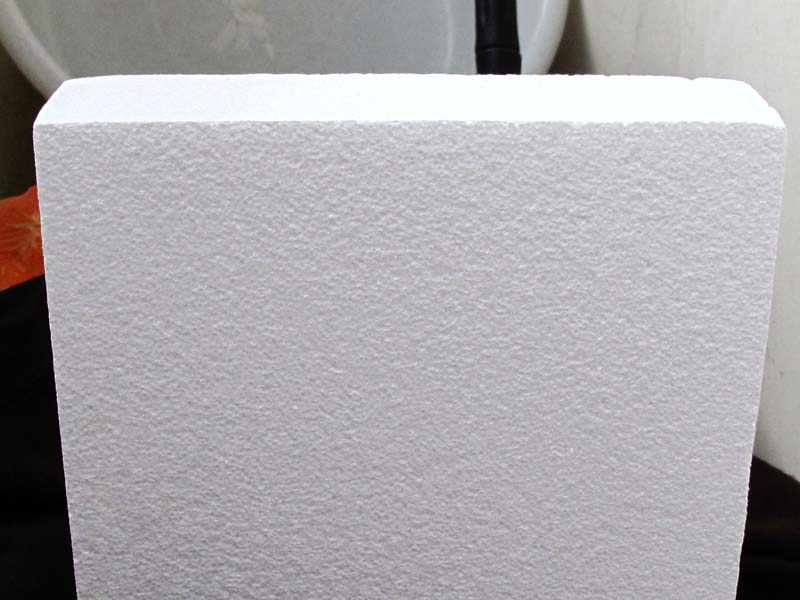

One of the features of a heat insulator should be considered a complex attitude towards combustion. Manufacturers claim that the foam is non-flammable and does not support combustion. As proof, a video is often shown in which a piece of insulation is unsuccessfully tried to set fire to a lighter. However, in reality the situation is more complicated. The pellets are filled with non-combustion carbon dioxide. But when the polystyrene is completely melted, the gas will escape, and the pool of liquid material will burn well. This point must be taken into account when choosing a heater.
Penofol
It is a roll material made from polyethylene foam. An additional element is an aluminum foil that forms a reflective layer. It directs infrared (heat) rays back into the room, which enhances the effect of the insulator. There are several types of foam, with a reflective layer on one and two sides, and there are types with a sticky layer to facilitate installation. The thickness of such insulation is small, and it can be put on the floor on top of the flooring made of boards, without dismantling the old floor. The layer of material is impervious to moisture and does not allow air to pass through. This has both positive and negative sides. When using such heaters, high-quality ventilation of the premises should be organized, otherwise water vapor will begin to settle on walls and other wooden surfaces.
Ecowool
Loose material that is applied by spraying using special equipment. Its peculiarity lies in the fact that the thickness of the spray layer on the wooden floor can be any and depends only on the wishes of the owner. This insulation is a cellulose flake obtained from the processing of waste paper and paper recyclable materials. At the same time, the composition does not contribute to the appearance of rodents. During its manufacture, additives of boric acid and borax are added to it, which scare away rats and prevent the ignition of the backfill layer. The main advantage of this insulation is considered to be high heat-saving qualities. However, the material also has a number of serious drawbacks:
- the ability to absorb moisture, which reduces the performance of the backfill layer;
- the need to use special equipment for styling.
In addition, ecowool is a rather expensive material, which reduces its attractiveness among users.
Foamed polymers
A group of materials, among which types of foamed polyethylene prevail. They have a small thickness, which allows them to be used without opening the sub-floor and without dismantling the flooring. Available in different types and shapes:
- rolls;
- mats;
- harnesses;
- shells (shells) for pipelines.
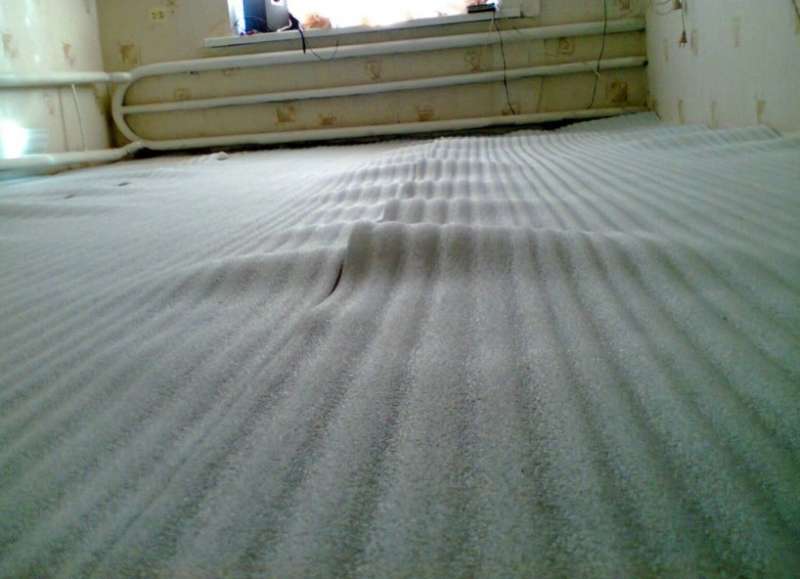

The scope of application of foamed polymer insulators is wide. They insulate the wooden floor, walls, and other surfaces. With high heat-saving qualities of the material, the layer thickness is small, which favorably distinguishes foamed polymer heat insulators from alternative types. They are convenient for laying under the slab joints, allow you to insulate roof slopes, floors or ceilings, and other surfaces. At the same time, they have not yet received wide distribution among users, since they appeared on sale relatively recently. When deciding how to properly insulate the floor in a wooden house, you can consider this group of insulation. Their prospects are quite large, and their capabilities and properties allow you to get a beneficial effect in any area.
Foam glass
Foam glass insulation was first created in the first half of the last century. However, in our country it is not widespread. The main reason for this was the high cost - in the manufacturing process, it is necessary to use heating the glass mass to the melting temperature (1000 °), which increases costs. Insulation has a good set of qualities:
- high strength;
- complete fire safety;
- environmental Safety;
- simple and convenient installation.
The disadvantages are the high weight and high cost of insulation. Foam glass is lighter than wood, but in comparison with other types of insulation, it is noticeably heavier. If it is necessary to install large amounts of material on the floor, an additional load arises on the supporting structures, which are not always ready for this.
Fibrolite
A material representing a sandwich of two layers of thin OSB, between which there is a compressed insulation. It is a composite made up of three main components:
- wood wool (fine fibers);
- cement powder;
- glue (liquid glass).
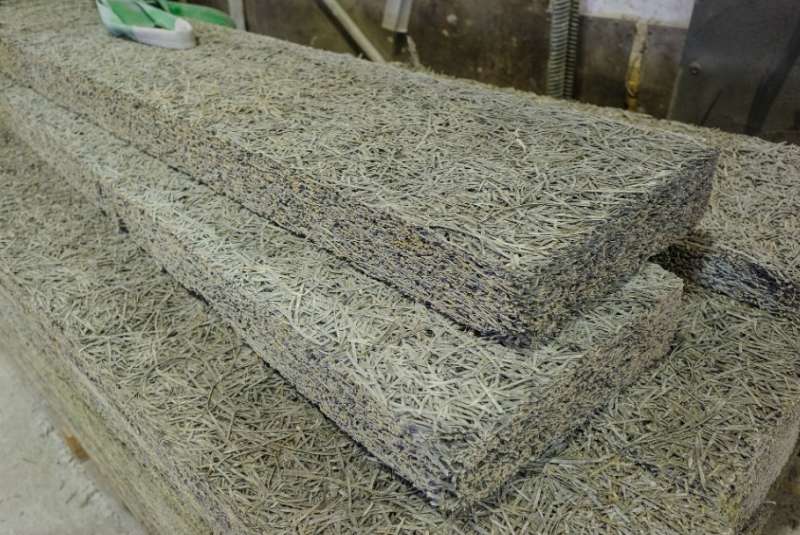

It is produced in the form of slabs, which makes it easier to install the material on the old flooring (top). A feature of fiberboard is its high ability to absorb moisture. Moreover, if the installation is carried out in several layers, the weight of the insulation increases noticeably. This reduces its operational value. For installation on the floor of the lower floor, this insulation is suitable with restrictions. It is not suitable for ground floors, but can be used on upper floors.
Izolon
This is another type of polyethylene foam equipped with a foil reflector. In terms of its qualities, this insulation is almost a complete analogue of penofol. Many users confuse these materials with each other. There are slight differences in polyethylene grades, layer thickness, roll length and other technological issues.The scope and installation method are no different.
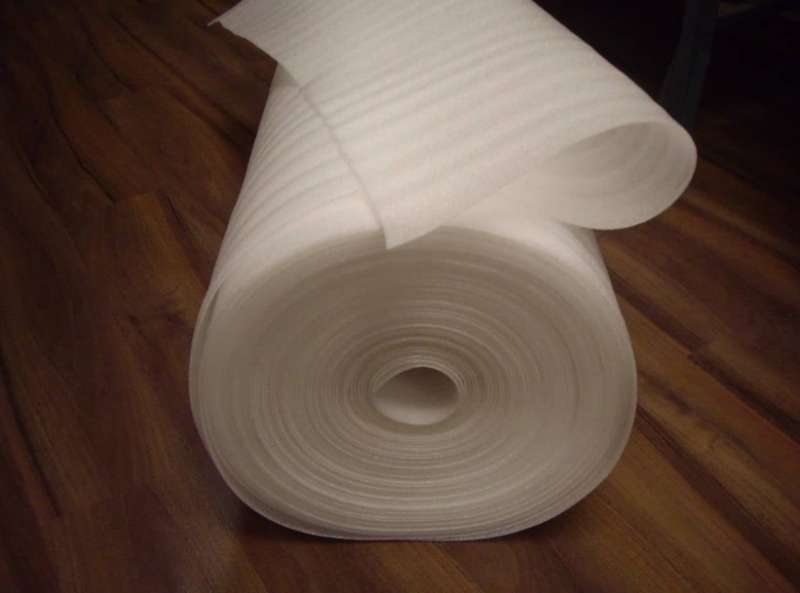

The specificity of the use of materials is also the same - areas requiring complete cut-off from moisture in all types.
Thermal insulator laying options
Depending on the type of floor to be insulated and the level of possibilities for carrying out insulation measures, work on laying the insulator can be carried out on top of wooden beams or from the bottom side. For example, if you want to insulate the floor on the first floor of a house without a basement, then the material can be fixed only from above. If there is a basement, some of the work can be done from below. Both options are discussed in more detail below.
Insulation from below
The least labor-intensive way to organize niches for the installation of insulation is by stuffing boards or other material in slabs or sheets on the underside of the beams. Not only new materials are suitable, but also used materials that have retained their quality and shape. It can be corrugated board, plywood, chipboard, etc.
If it is planned to use foam or mineral wool slabs for insulation, then before stuffing the lower plank base, a film waterproofing coating with a thickness of 0.2 millimeters should be laid. It is laid across the beams in strips, their edges should overlap each other by 10-20 centimeters.
Further work is done from the side of the room. The heat insulator must first be cut in accordance with the dimensions of the interbeam space. There is an important nuance in this work - the insulation should fill the space as closely as possible in width and height. This means that when pruning, you should leave a small margin for a tighter fit to the lags. It is allowed to lay the material in several layers in height.
The next phase of work is vapor insulation. For it, an already known polyethylene film or a vapor barrier membrane is used, it is laid in the same way with the arrangement of vapor protection. Fastening is carried out on small nails or staples of a construction stapler, and the joints are glued for tightness.
Insulation on top
This technique has significant differences from the previous one in at least two points:
- The niche for laying the insulating material is formed from cranial bars, and plywood, boards or other flat-shaped material is attached on top.
- The lower waterproofing layer is built over the mounted structure and attached to the end parts of the wooden beams.
Arranging the insulating layer in this way is somewhat more complicated than in the previous version, but it has its own advantages. One of the advantages is the saving of insulation, because the thickness of the layer will need to be reduced in accordance with the thickness of the cranial bar, which is 5 centimeters.
The photo below clearly shows an example of the formation of a plank niche on top of the cranial bars. The boards are simply cut to the required size, then they are laid perpendicular to the beams and fixed on nails or screws.
As for the installation of waterproofing, the following photo clearly demonstrates the technique of laying it on top of the floor beams and insulation material. The film coating will form a cavity for laying the heat insulator, and therefore should sag a little.
The rest of the activities are carried out according to the technology of the first scheme. In particular:
- the material for insulation is laid in the formed niches and pressed against the bars as tightly as possible;
- a waterproofing film is laid on top of the thermal insulation layer and the overlap lag;
- over the assembled "cake" of insulation, a sub-floor is mounted, at the same time serving as a protective coating.
When the ceiling is assembled on the floor beams, it is important to understand that this part of the structure will be constantly visible in the future, which means it should have a presentable appearance.Such a ceiling is usually assembled from 10 mm plywood or boards (edged or grooved), the thickness of which is 25 mm.
Technical requirements
A wooden building always seems to us warm and cozy, thanks to natural materials. But we must not forget that wood tends to absorb moisture, so a warm floor in a house made of a bar always resembles a puff cake:
- First, special beams (logs) are laid;
- Then the first (rough) layer of boards is laid;
- The entire surface is tightened with insulation;
- Another boarding (finishing);
- Decorative coating is possible (laminate, linoleum, painting, etc.).
This is the only way to achieve floor insulation in a log house. The choice of material must be taken into account, since the platform under your feet must be quite rigid and durable. A certain thickness of logs and boards affects the quality of the coating in order to exclude unpleasant squeaking underfoot. From the bottom of the ground, the tree pulls dampness, so the insulation should be as dry as possible before laying.
For the top coating, a material is selected that will complement the interior of the house, add coziness and comfort, and will also be environmentally friendly and fireproof. If the warm floor in the house is made of a log of high quality, you can simply cover it with a protective agent, and then apply a layer of varnish. This will preserve the natural pattern of the wood and improve the overall impression of the interior of the wooden building.
Work technology
The most effective insulation of the interfloor floor will be if it is carried out during the construction process. It is in this case that you can take into account all the subtleties and apply all available materials.
If the interfloor floor is not yet ready, but only represents a set of wooden beams laid on load-bearing walls, it is necessary to mount a vapor barrier layer on the lower surface, and then hem the ceiling of the lower floor. As a result, if you look at the ceiling from the side of the upper floor, it will be several long boxes formed by the beams and ceiling covering.
It is in these boxes that you need to put insulation. After the material is laid in the space between the beams, it must be covered with a second layer of vapor barrier. Sheets or panels must be overlapped and glued together. Logs are mounted immediately along the upper layer of the vapor barrier, onto which the floor boards of the upper floor will subsequently be laid.
If we insulate the finished floor, as is often the case during the overhaul of residential buildings, the insulation will have to be mounted on the underside of the floor. For this, from the side of the ceiling of the lower floor or basement, a frame is arranged along wooden bars or metal profiles.
Correctly executed insulation will protect from frost, heat in summer, and will provide good sound insulation.
We suggest that you familiarize yourself with How to update tiles on the floor
Own house made of wood is deservedly considered the most environmentally friendly type of home and is the dream of almost every city dweller. Nowadays, one-story buildings are a rarity; two-story houses are much more common, where guest or children's rooms, bedrooms and recreation areas are located on the second floor.
After the ceiling of the second floor is insulated, care should be taken to prevent heat loss through the ceiling. The attic is located in close proximity to the roofing. The role of insulation is played by mineral wool, which is recognized by experts as one of the best materials for insulating an attic. Those who are concerned about environmental friendliness prefer ecowool. Wool of the selected type is laid in the cells formed by the rafter structure.
- by pressing mineral wool into the cells of the rafter structure. The thickness of the slabs must be at least 20 cm.This method is the most costly, but it is very popular among builders, as it is simple to execute;
- laying insulation boards only under the rafters, which requires additional lathing. The consequence of such insulation will be a decrease in the volume of the attic. Homeowners rarely make such sacrifices;
- installation of mineral wool slabs under the rafters and between them, which requires the installation of additional frame elements. Given the reasonable costs of labor and material, this method has its adherents.
We wrote in detail about the attic insulation here
Correct insulation of the second floor overlap will reliably protect the home from the penetration of cold air. In addition, it will increase noise absorption and provide protection from moisture. Next, we will consider all the nuances of this operation.
Lags and counter grill
When installing the lag, they are placed with a step corresponding to the format of the insulation used. To avoid the frequent installation of support pillars, you can use a cross lag system. In this case, the lower beams have a cross-section with equal sides and perform the main load-bearing function. The upper row has a frame device: the boards, placed on the edge, form longitudinal cells, convenient for laying insulation of a certain width and fastening the floorboards.
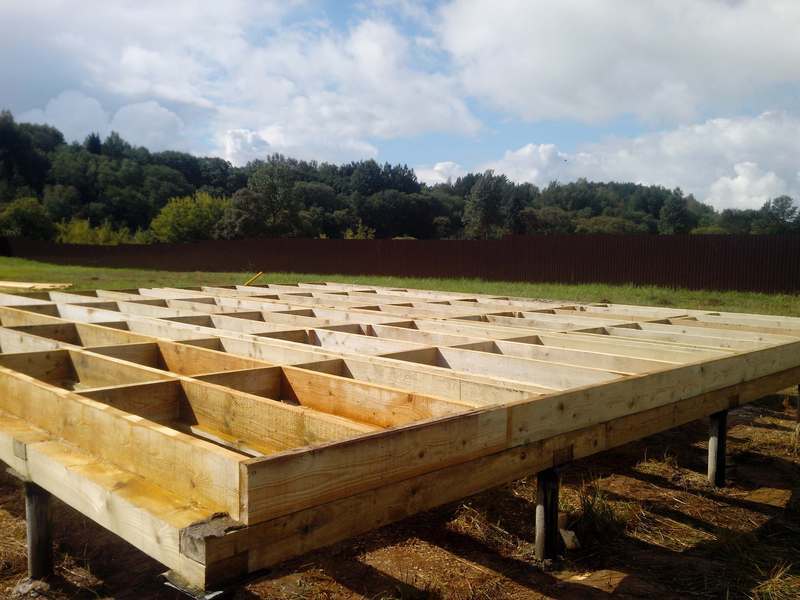

If the house is located on a slab foundation, then the supporting floor system has the simplest device. Lags are formed by one frame row, which is fixed with anchors to a concrete base. The plane of the monolithic base forms the bottom for the cells for the insulation, ensuring its reliable fixation.
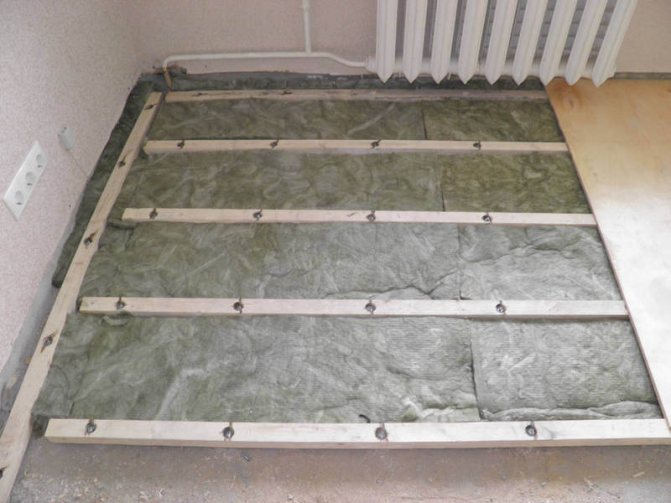

When installing the floor on the ground, there is no such reference plane. One of the options to arrange it is to fill it with a light porous material, such as expanded perlite or expanded clay, to the lower level of the lags.
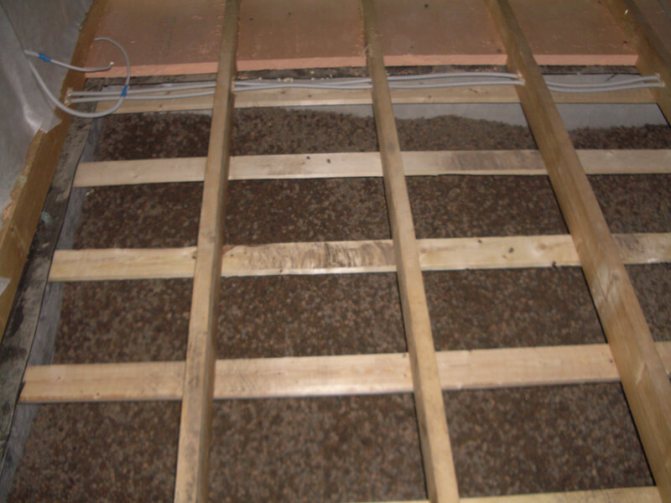

Otherwise, the logs that form the cells for the insulation are supplied with longitudinal stops. A bar of about 25x25 mm is screwed with self-tapping screws at the bottom of each log, forming parallel ledges. A shingle net or a thin edged board is laid on them, due to which the insulation is supported.


1 - cranial bar; 2 - floor lag; 3 - mesh; 4 - vapor barrier; 5 - insulation; 6 - floor board
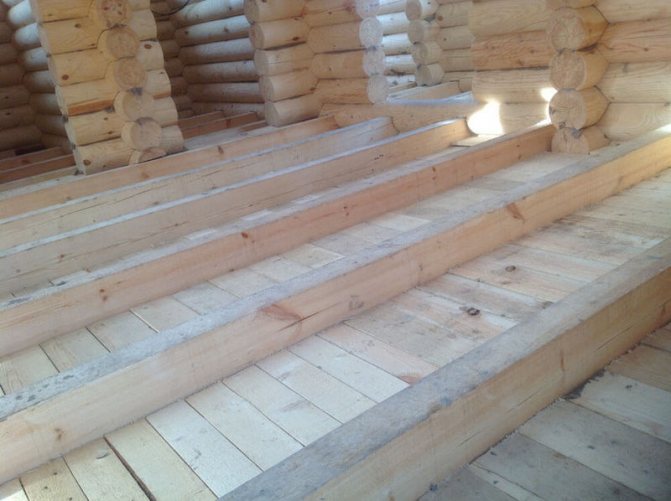

It is important to know that since the stuffed bars "eat up" the space of the floor cells a little, the remaining height may not be enough to accommodate the insulation of such a thickness, which is provided for by the heat engineering calculation. In this case, bars of the same size are stuffed over the edges of the frame system. They can be located parallel or across the top row of the logs, in the latter case, an additional gap is provided for ventilating the insulation.
What materials to use - choose the best option
Various materials can be used to insulate the space between floors. Next, we will consider the most popular of them and their features.
Styrofoam
This is the least effective analogue, which is still popular anyway. It can be recommended only for residents of warm regions, where houses do not need careful thermal insulation. Its main advantage is its low cost. In addition, it provides excellent sound insulation (on the lower floor you will not hear footsteps or furniture movement). Another plus is that it is easy to work with.
It makes no sense to list all the disadvantages of foam, because it has the worst technical characteristics in its class. In cold regions, its use is almost meaningless.
Most often it is called penoplex, and is also confused with polystyrene (outwardly they are similar). They have only the raw materials in common, but the production methods differ radically. As a result, this insulation turns out to be very dense, so it can be plastered immediately, or used as a subfloor. The features are as follows:
- High density.
- Lowest thermal conductivity (best in class). This speaks for maximum efficiency.
- Convenient to work (easy to cut).
- Harmless to humans.
- Very light weight, so there is no need for a solid structure between floors.
- Lights up (class G4). Apart from the high cost, this is the only drawback.
Despite its subtlety, it is a very effective insulation (second only to penoplex). It can be recommended when there is not enough space between floors to insert a thicker mat. However, such material is often used for other reasons.
It is sold in the form of rolls 100-120 cm wide, and the thickness can reach 2 cm. It almost completely reflects heat, preventing it from escaping outside. The main feature is that it is not "afraid" of moisture at all, so it is often used when creating a moisture-proof layer. For houses located in the far north, the combined use of foam and foil-clad polyethylene (laid as a vapor barrier film) can be recommended.
Minvata
Mineral wool is the most popular insulation today, which is used in all areas. The most effective is the basalt variety, therefore we will stop at it.
Let's highlight the key advantages:
- Non-flammable (unlike glass wool).
- High compressive strength.
- Good hydrophobicity.
- Provides additional sound insulation (in this it outperforms penoplex). On the lower floor, no footsteps will be heard from above.
- Resistant to natural and chemical irritants.
It is difficult to single out pronounced disadvantages (apart from the high cost). Along with penoplex, this is the most effective option.
In the table below, you can see a comparison of the described heaters according to their main characteristics.
Styrofoam
- Loose materials (expanded clay, wood concrete, shavings) - have good thermal insulation qualities, are relatively inexpensive;
- Mineral wool and glass wool - effective in terms of heat and sound insulation, fireproof, not susceptible to infection by fungi and rodent attacks, hygroscopic (require mandatory vapor barrier);
- Polyfoam and expanded polystyrene - materials are moisture resistant, not subject to deformation, do not ignite, conduct heat poorly, drown out sound noises.
It is impossible to say which of these materials is the best. You need to choose based on your financial capabilities and functionality of the insulated room.
Arrangement of the subfloor
After the completion of the construction of the structure, they proceed to the construction of the subfloor. Very often this coating is done during the construction of walls, since the craftsmen lay temporary boards for the convenience of construction. The rough flooring serves as a supporting part of the insulation, is involved in determining the rigidity of the floor.
At the bottom of the side beams, a 50 * 50 mm cranial block is hemmed, which is a support for attaching the boards. When equipping the rough floor, use a board 2.5 cm thick. The prepared boards are fastened with self-tapping screws.
Next, waterproofing is installed. To do this, use a film (roofing material), modern materials, for example, inexpensive glassine. Roofing material (film) is laid in several layers, fixing with glue (bitumen). If the glassine is not wide enough, it is overlapped.
Warming recommendations
The technology for insulating the floor between the floors of a wooden house practically does not differ from standard insulation procedures. However, certain nuances are still present. Therefore, we will consider this process in detail.
Insulation of the interfloor space of a wooden house will reliably keep warm. This procedure consists in laying insulating material between the beams. The simplest option is to do the work on the second floor (that is, to lay the floor).If you do the installation from below, you will have to fix the insulation to the ceiling, which is much more difficult (installation of a canopy takes a lot of effort). First, you need to make preparatory operations:
- We remove the entire floor from the second floor. First, we dismantle the topcoat. If it is plywood or a similar material, then unscrew the sheets with a screwdriver. With laminate, parquet or linoleum, it is even easier - you just need to remove the coating.
- We also disassemble the rough cover. If the house is relatively new and everything is in good condition, then do it carefully so as not to damage anything. Subsequently, you can install everything back.
- As a subfloor for the second floor (if we are talking about a wooden house), as a rule, thick plywood or "forty" (40 mm thick board) is used. If the cover is screwed on, we use a screwdriver, and a pull-out is needed for the nails.
- As a result, we have to get to the wooden beams, which serve as a guarantor of the strength of the house. There should be nothing between them, so we remove all the garbage, the remnants of the old insulation (if any), etc.
- The wooden elements of the house need additional protection, so we coat the entire space with antiseptics or similar compounds. This will prevent wood from rotting.
- So that in the process of work you can safely walk on the second floor, we throw several boards along the beams.
So, the space between the floors has been prepared and it remains to insulate. We carry out the work in the following sequence:
- We carefully evaluate the integrity of the coatings - through slots are unacceptable. If there are any, we cover it with a sealant or cement mortar. Even the smallest gaps will promote air circulation, which will lead to heat loss and active condensation.
- After making sure of the integrity of the coating, it is necessary to lay a vapor barrier film. It will protect the heat insulator from condensation (from the 1st floor). In stores, you can find many analogs with different characteristics and, as a result, prices. However, in terms of efficiency, there are few differences, so it makes no sense to purchase expensive models.
- We measure the space between the beams and add 10-15 cm to it. Cut the pieces of the film and glue it to the surface. The material should go a little on the beams (for this, the excess was left).
Stages of building a floor in a house from a bar
Builders who work constantly with wood know how to make the floors in a log house. They prepare for this in advance, calculating the required amount of materials, discussing all issues with the customer. To hand over a house on a turnkey basis does not mean to forget about the constructed object forever. The builders leave, and the fame of the quality of their construction goes after them. To maintain their reputation, the craftsmen try to carry out all the work in accordance with the technological requirements.
They follow the sequence of flooring, starting with the laying of the walls. A wooden house is created like a monolith, so any inaccuracies in installation can lead to negative consequences. Violations lead to the fact that the logs are uneven, the boards then begin to move and creak. If the insulation material is improperly laid, the device of the floor in the house from a log leads to drafts, dampness and loss of 10-15% of heat. Boards that have high humidity quickly become infected with fungi, rot and become unusable.
If the owner is skilled, he always dreams of building a house on his own. Therefore, he begins to study the question of how to make a floor in a house from a bar long before the start of construction. You should not neglect the advice of professionals, as well as select the necessary tools, purchase a sufficient amount of dry timber, boards, beams.
Wood material can be dried naturally when folded under a cover for a long time. The method of drying wood in special chambers is considered more modern.They are available only in specialized farms. Such a purchase will be more reliable, but significantly higher in cost.
Developers are offered many options for arranging floors, one should dwell on a specific one even at the design stage. This will prevent mistakes and violations of building codes and regulations. Thus, it will be possible to deliver reliable and durable floors.
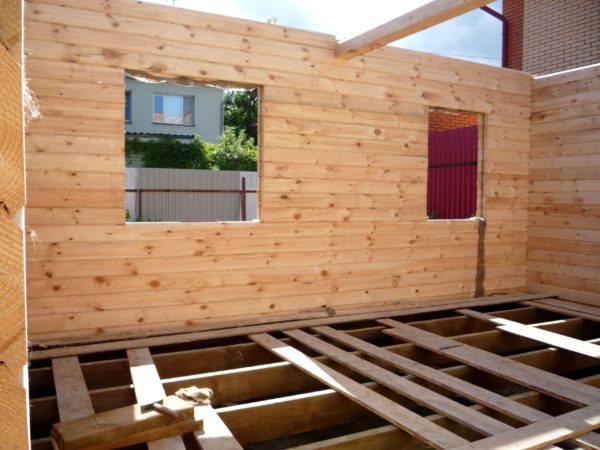

You need to decide on the type of floor in advance.
Table. What types of floors are used in timber houses?
| Floor type | Brief description of performance |
| Heated | Relatively new and quite fashionable flooring options. Heating the room at a zero level is the most profitable option from both an economic and operational point of view. If warm air rises from the floor, then the entire volume of the room warms up optimally, and the most favorable temperature is located at the level of 1.5 m, and not under the ceiling. This makes it possible to save significant financial resources during the heating season. The heat carrier can be water or electricity. But, unfortunately, it is categorically not recommended to install heated floors in houses from a bar. Why? Firstly, in wooden houses, natural boards are the best option for finishing, this is natural. And they conduct heat very poorly, as a result of this, the efficiency of using heat carriers is significantly reduced, all the advantages of bottom heating are leveled. It is not advisable to make floors in wooden houses from ceramic tiles or other coatings with high thermal conductivity. They have a very large weight, they are afraid of fluctuations in linear dimensions, and cobbled buildings must have them. Secondly, if the water floor heating circuit leaks, the consequences for wooden structures are extremely negative. Thirdly, in the event of a short circuit, the likelihood of the building catching fire increases. |
| Insulated | The most optimal option for arranging floors in wooden houses. Mineral wool is used as a heater; it is not recommended to use foam. The floor has several separate elements, each of which has its own function. When installing these floors, it is very important to make effective natural ventilation of the underground space. Otherwise, the tree is damp, quickly affected by fungus and rot. In terms of operational parameters, insulated floors meet the requirements of developers and regulatory enactments for the heat saving of buildings. |
| Cold | It is used only in non-residential or technical premises. Has a simple device, various options for finishing floor coverings are possible. Can be installed without subfloor. |
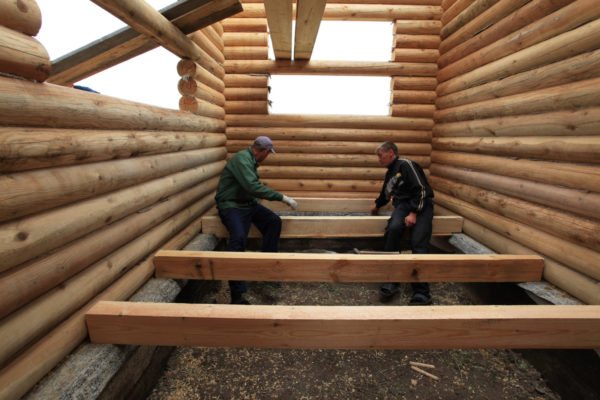

How to make a floor in a house from a bar

